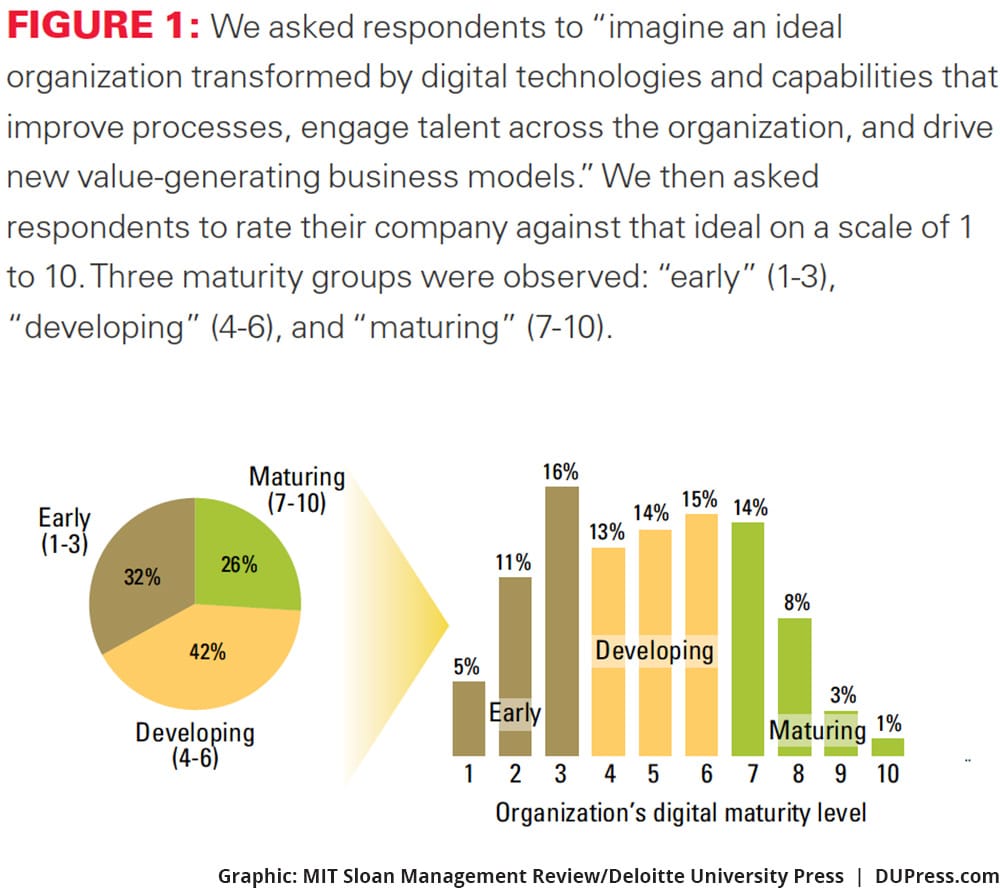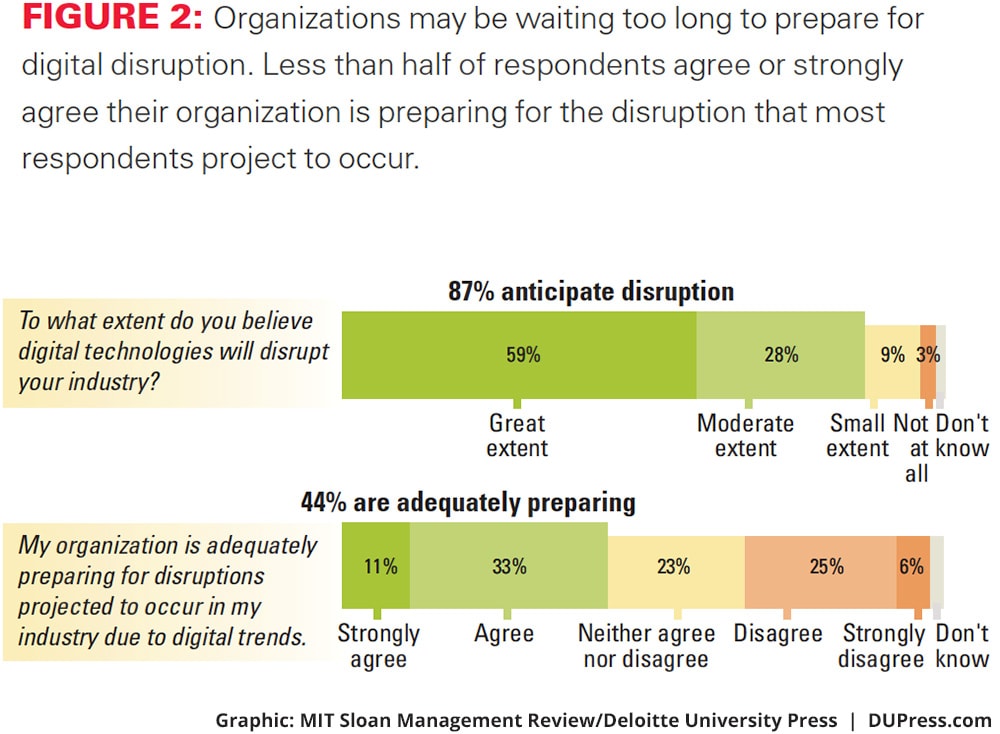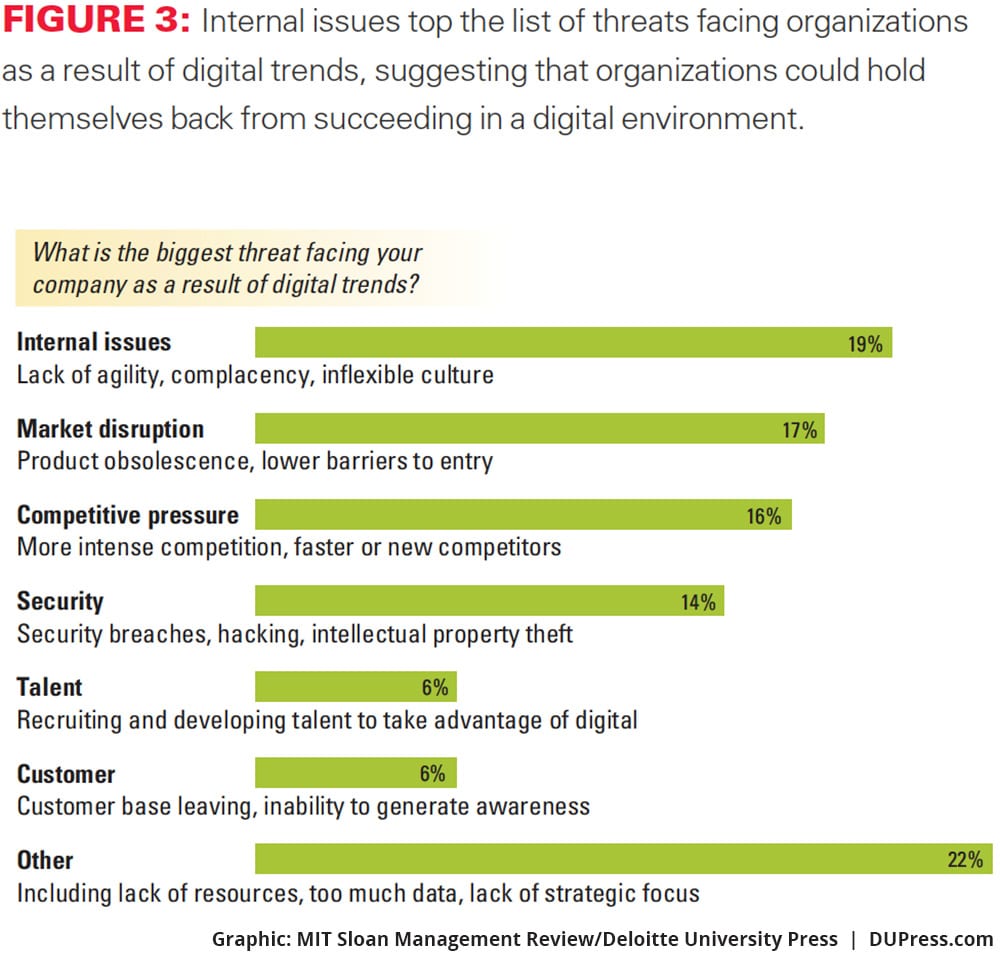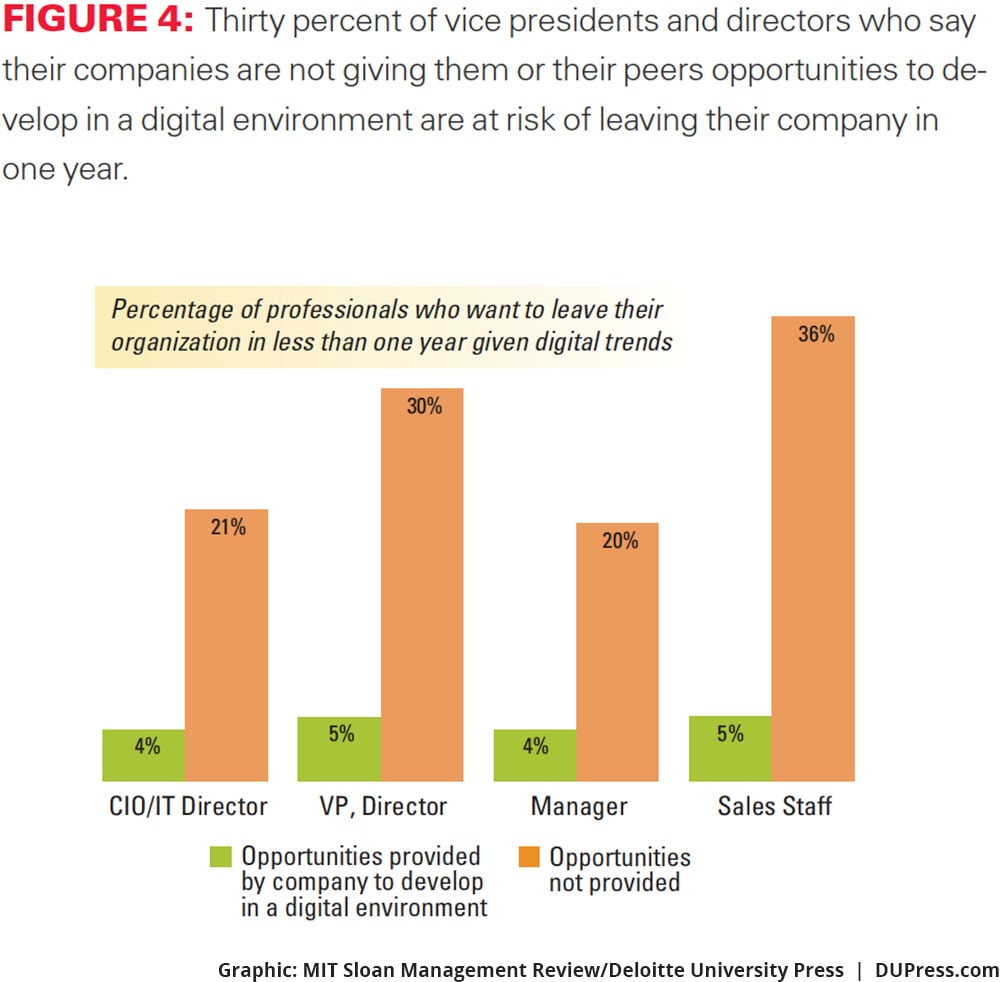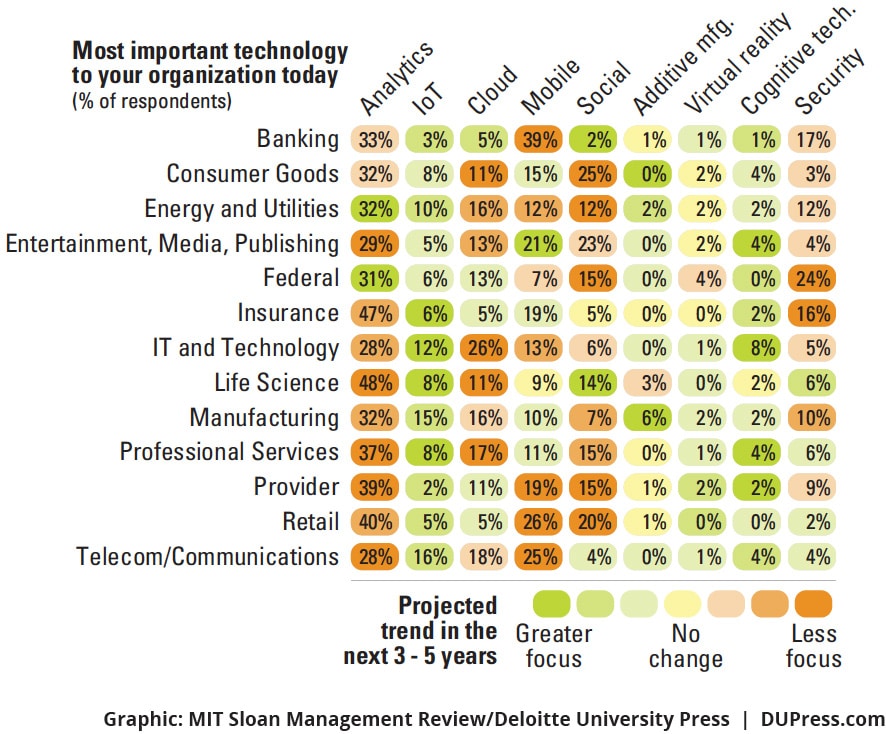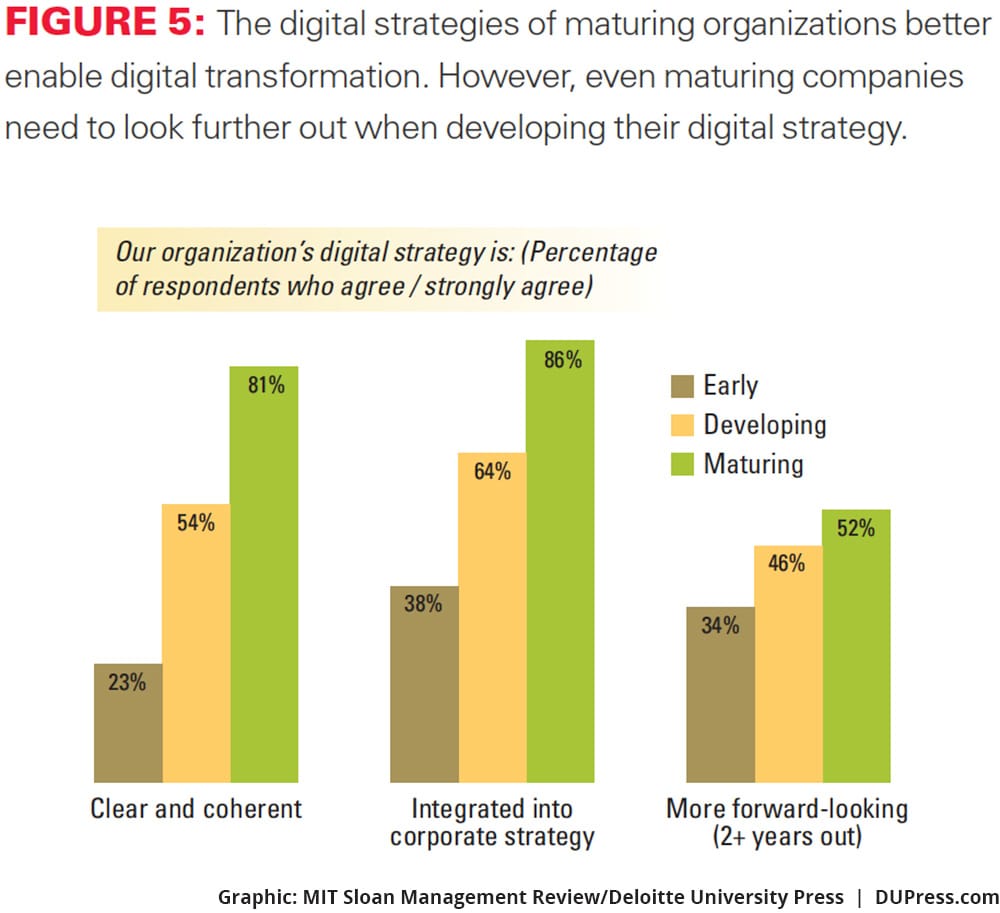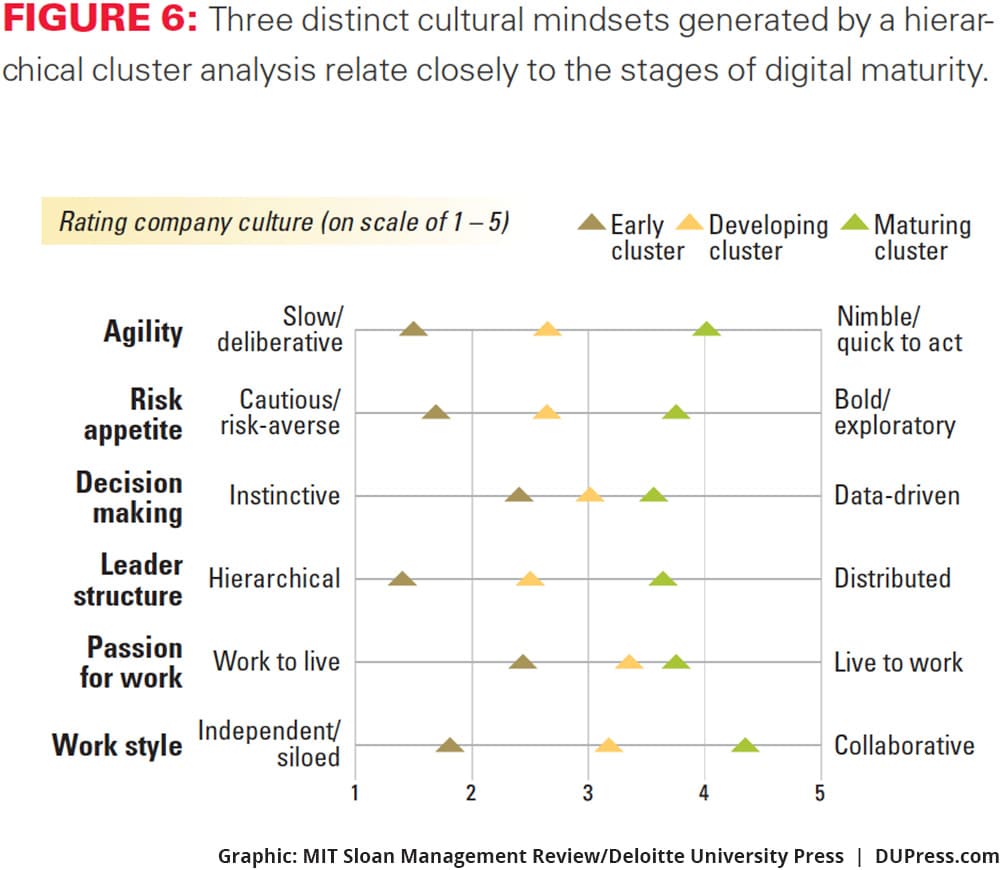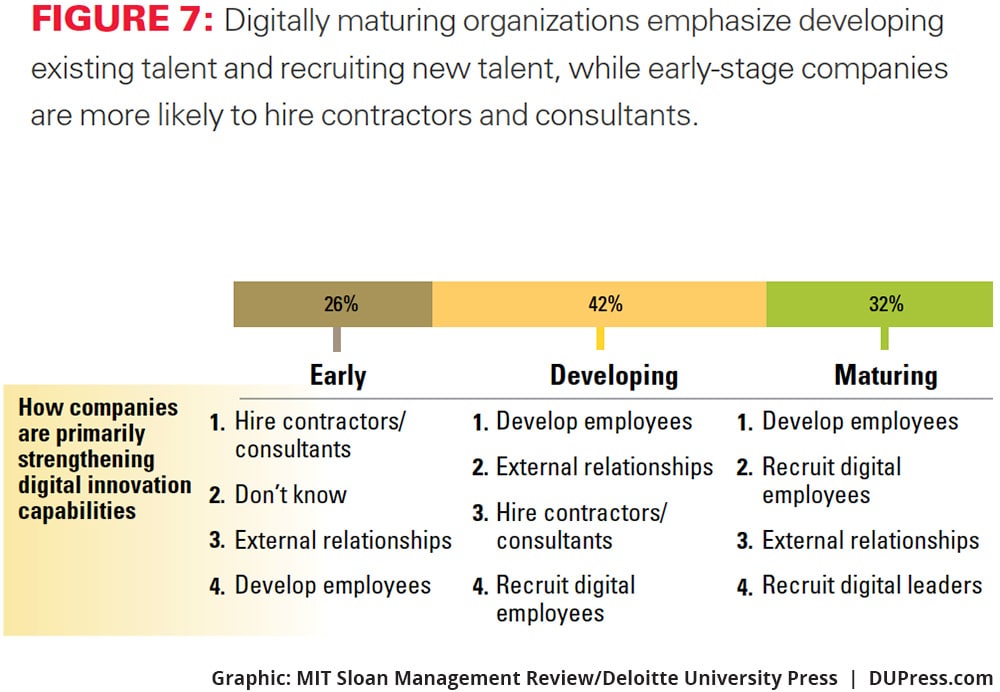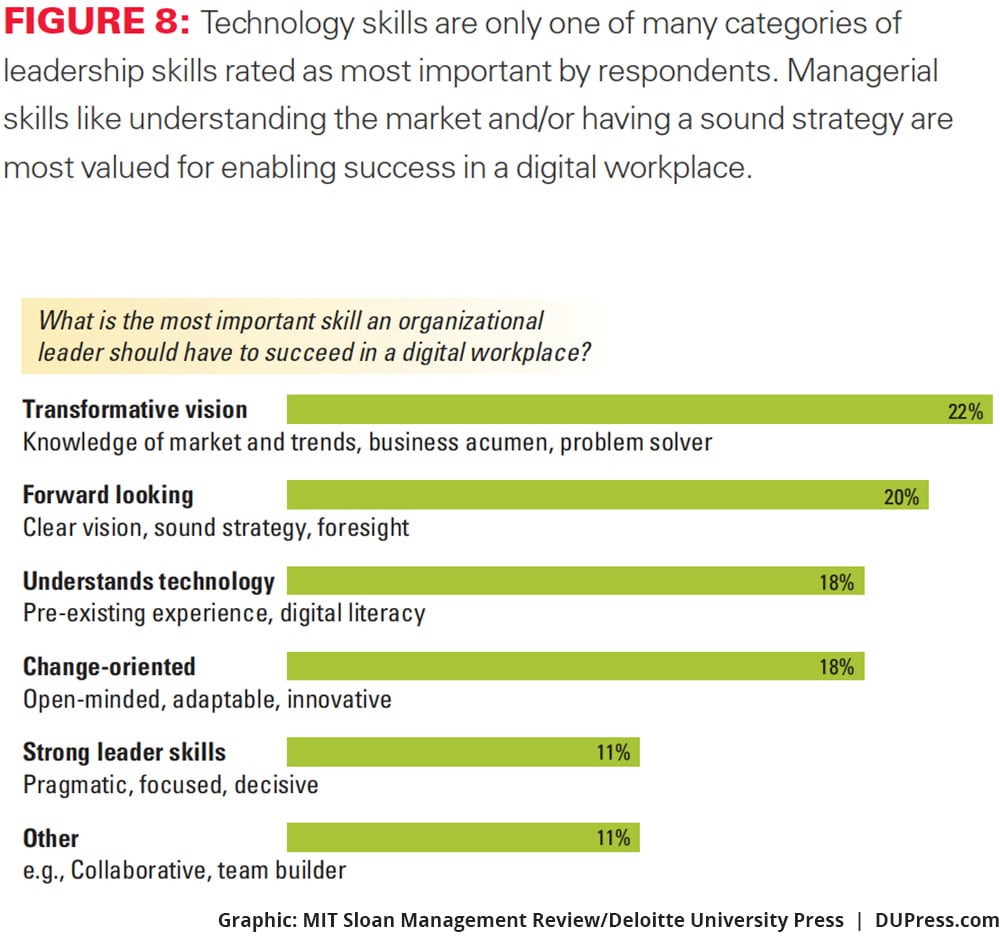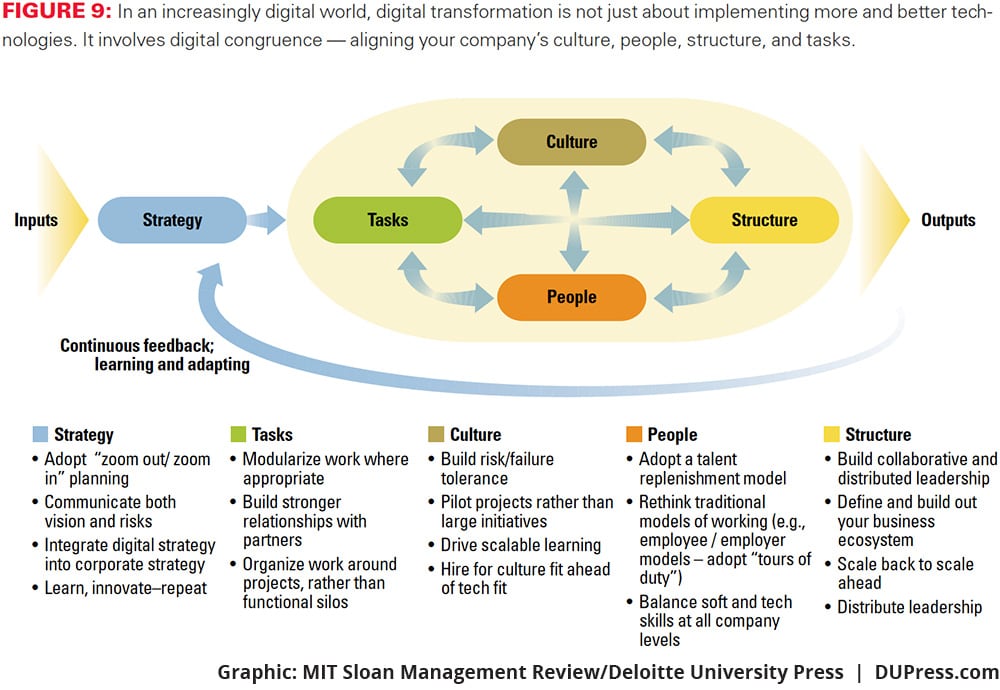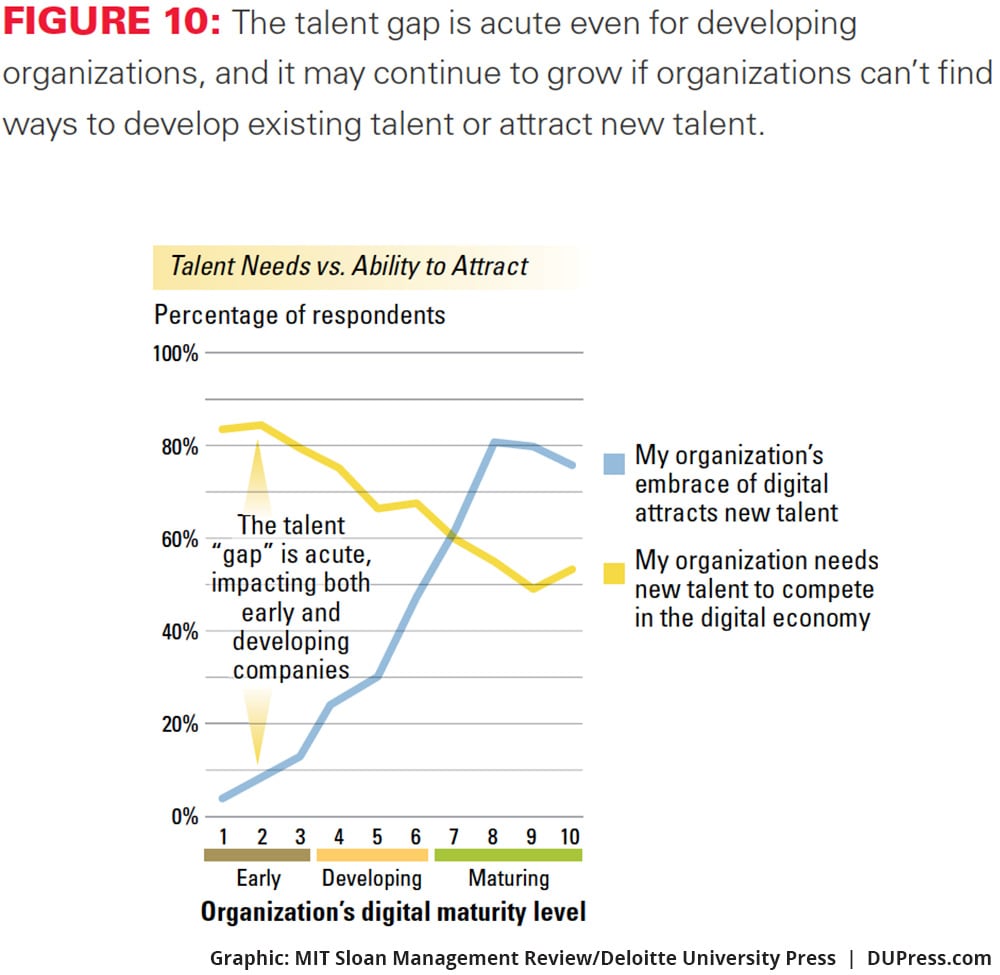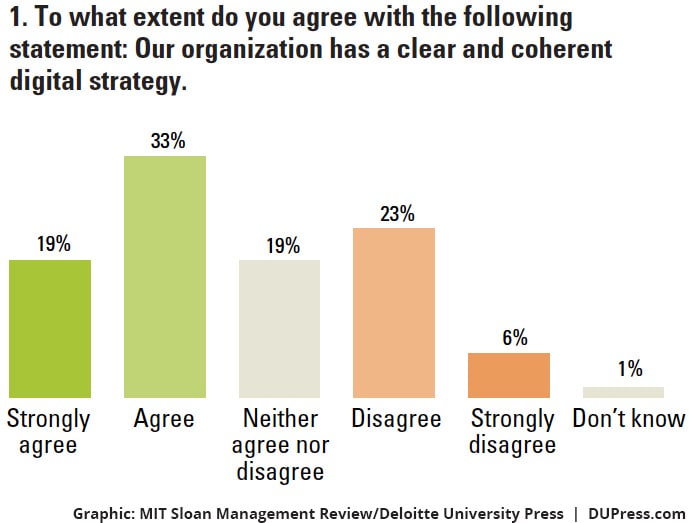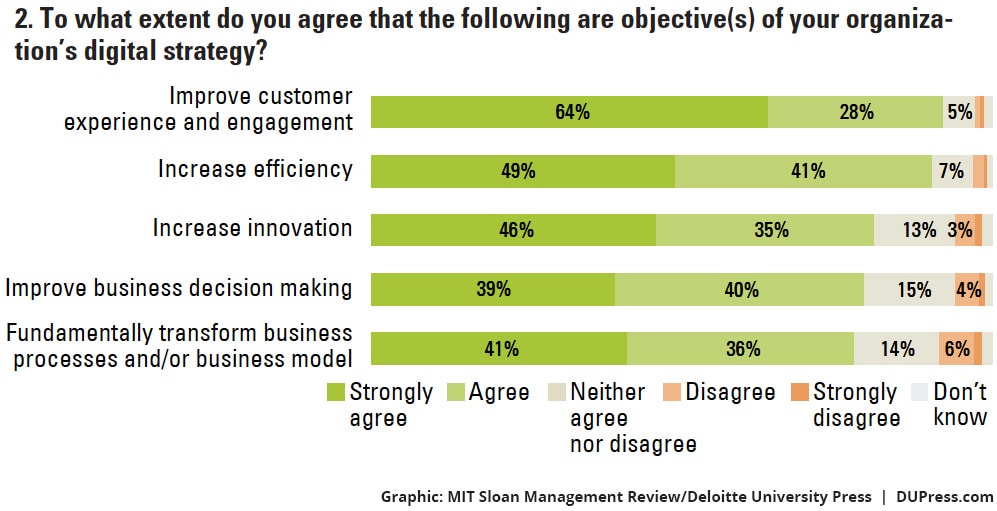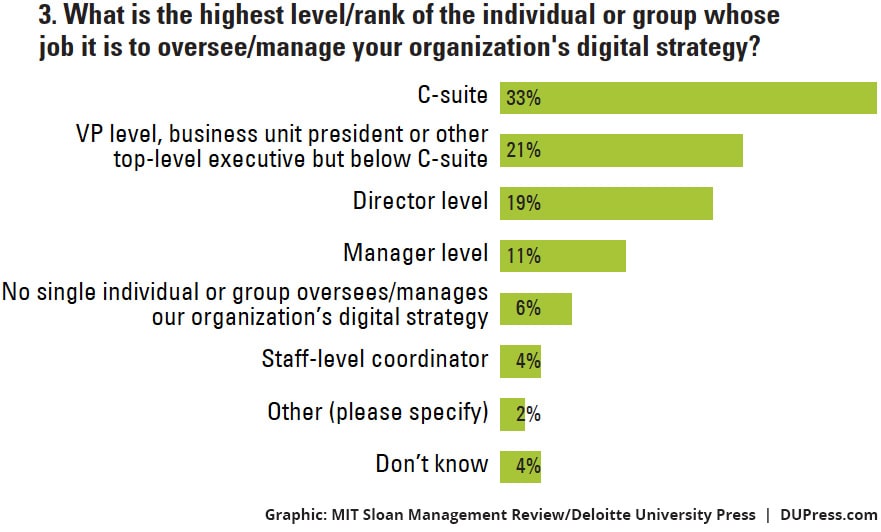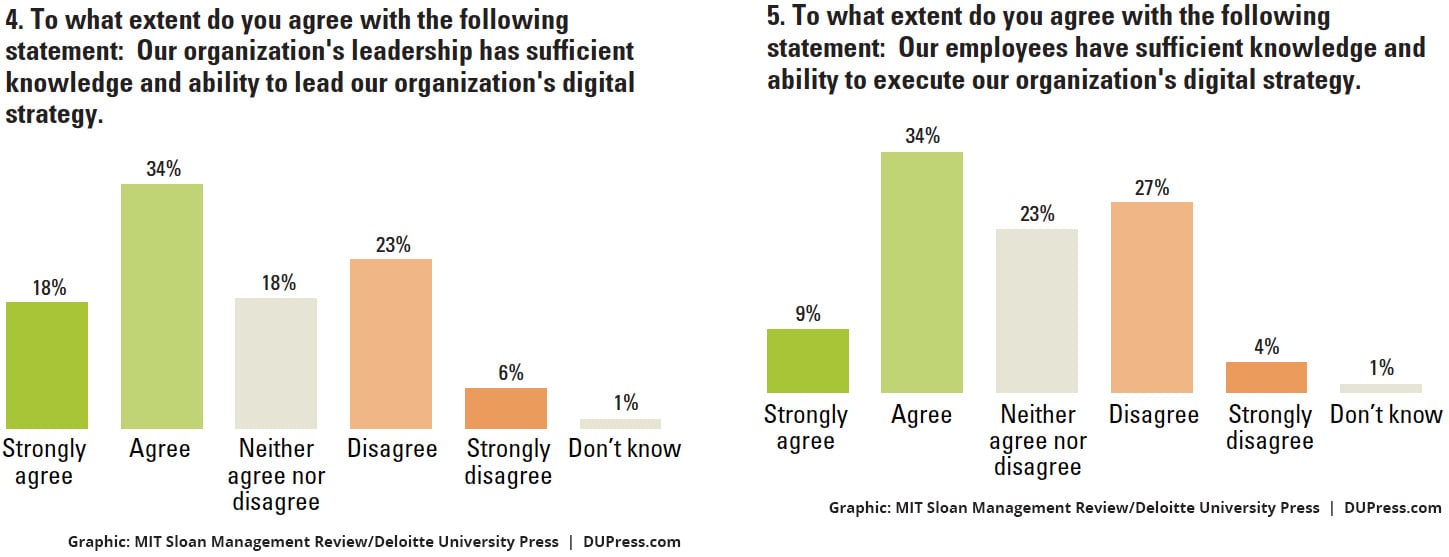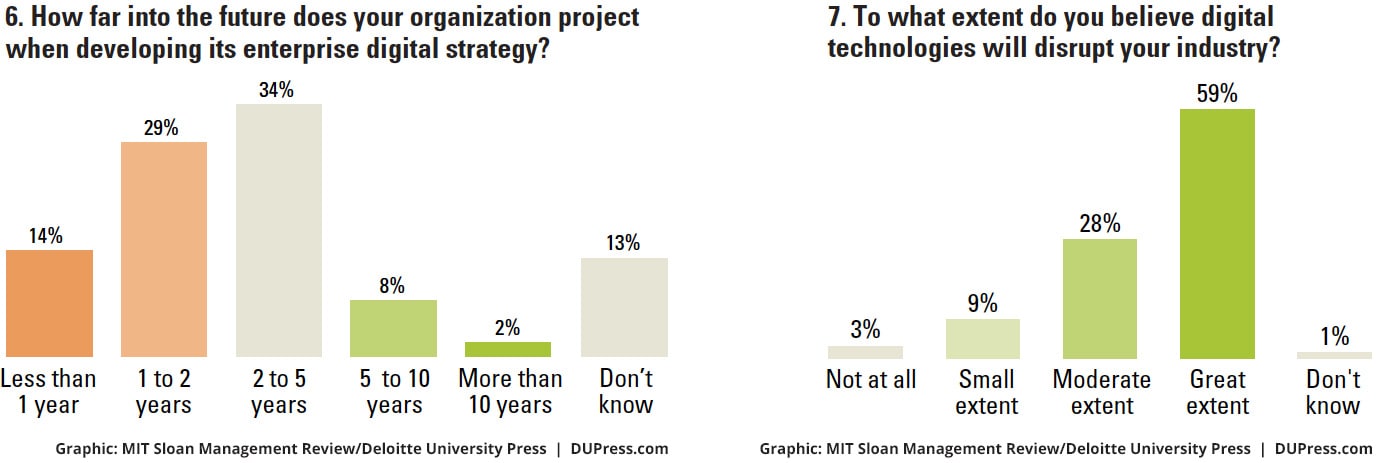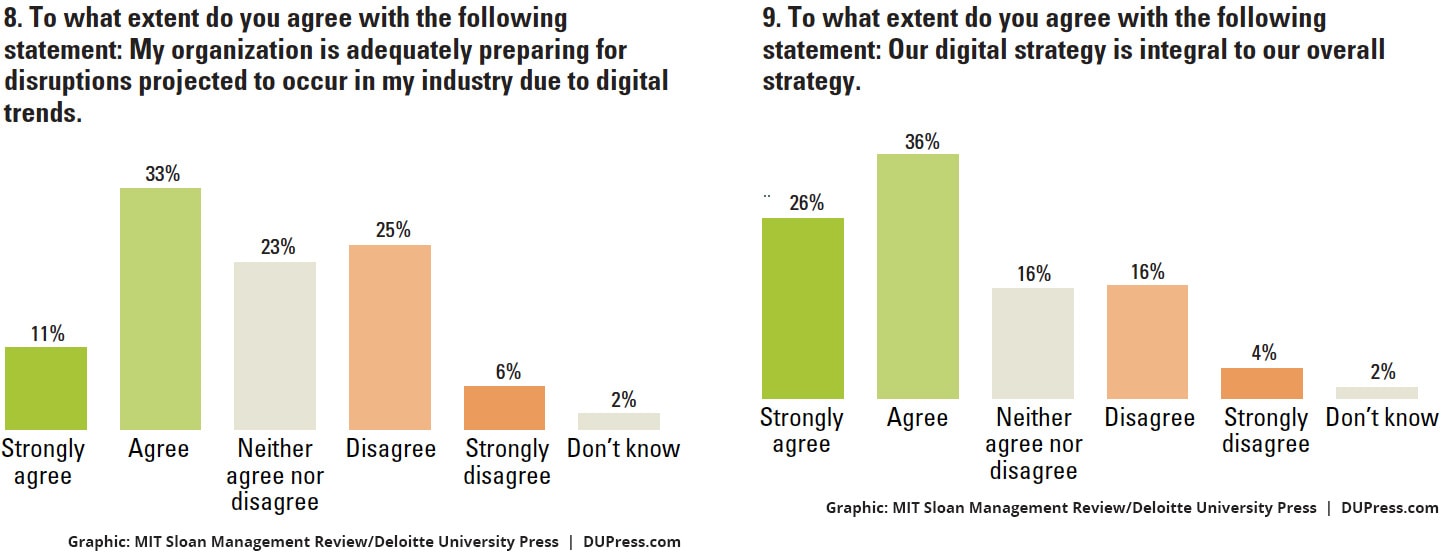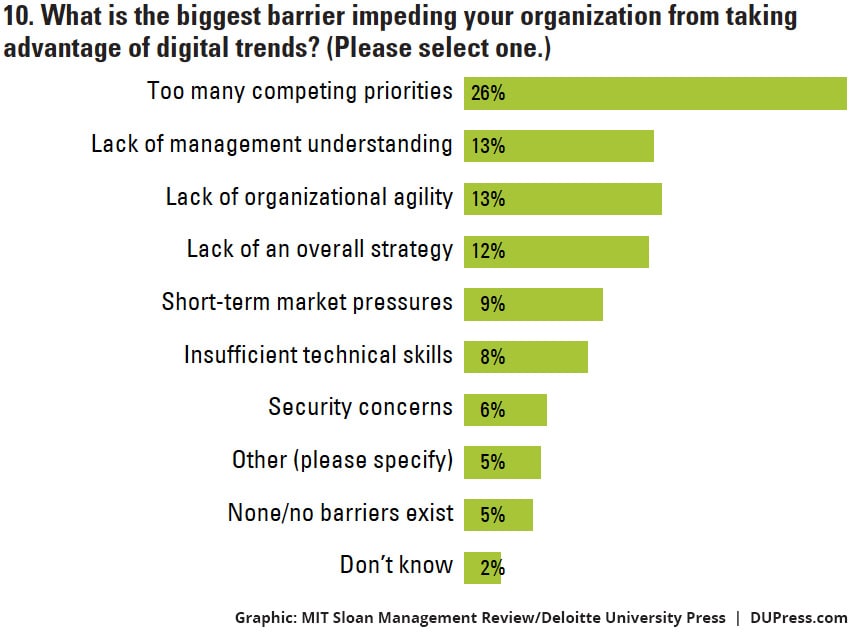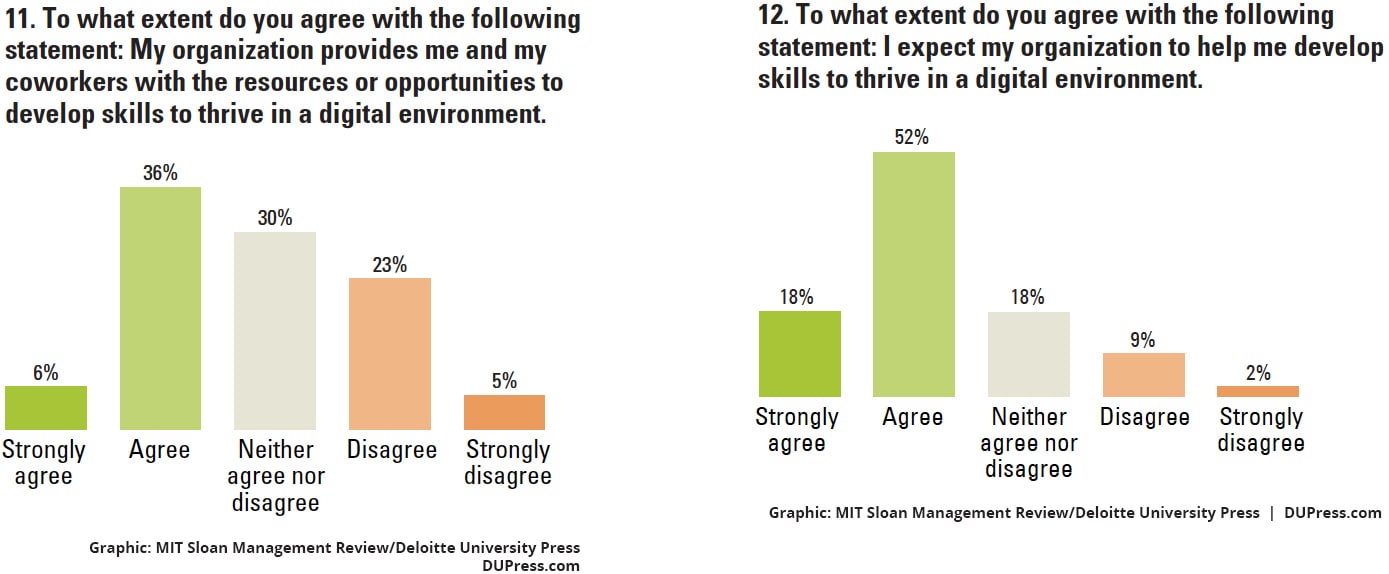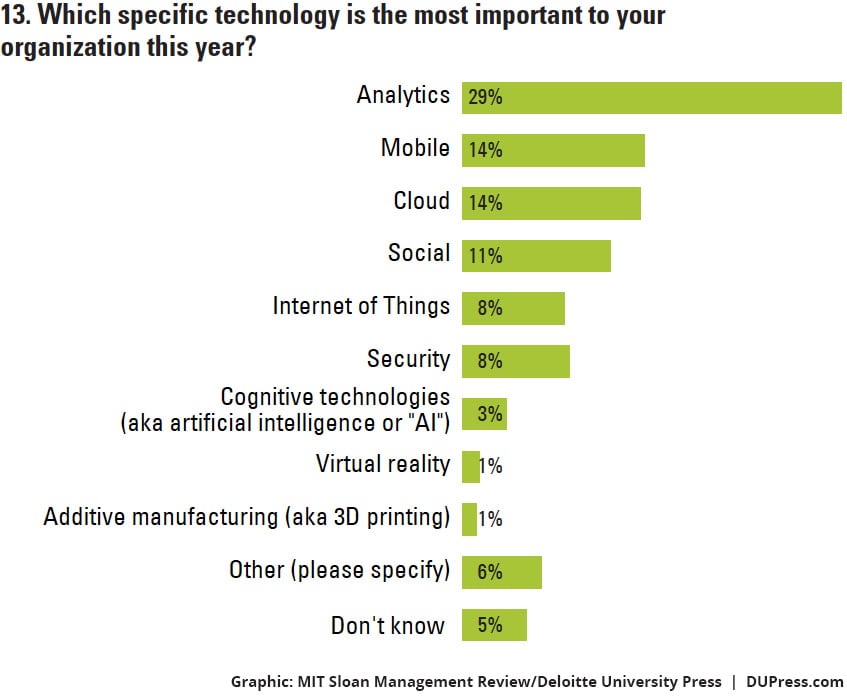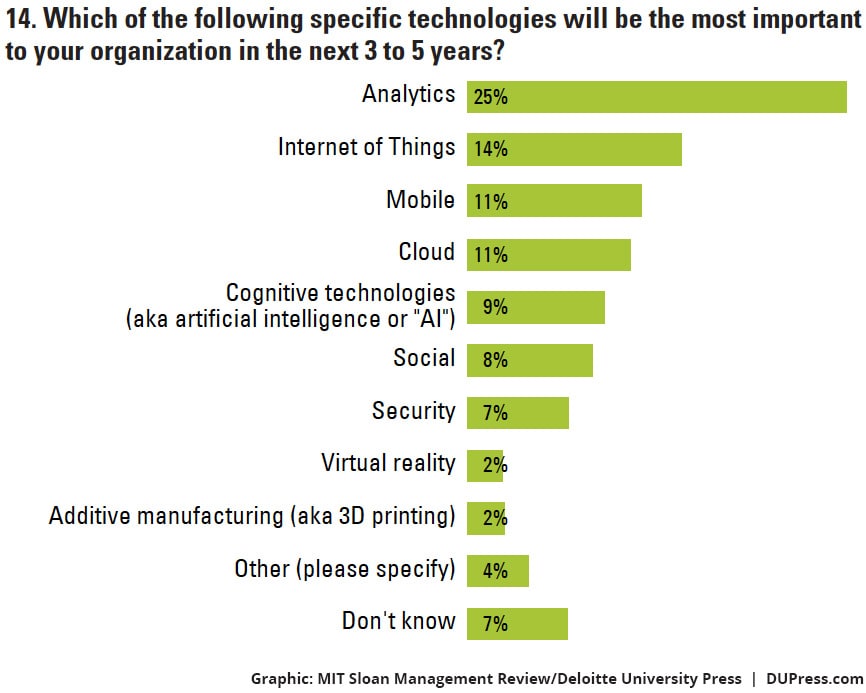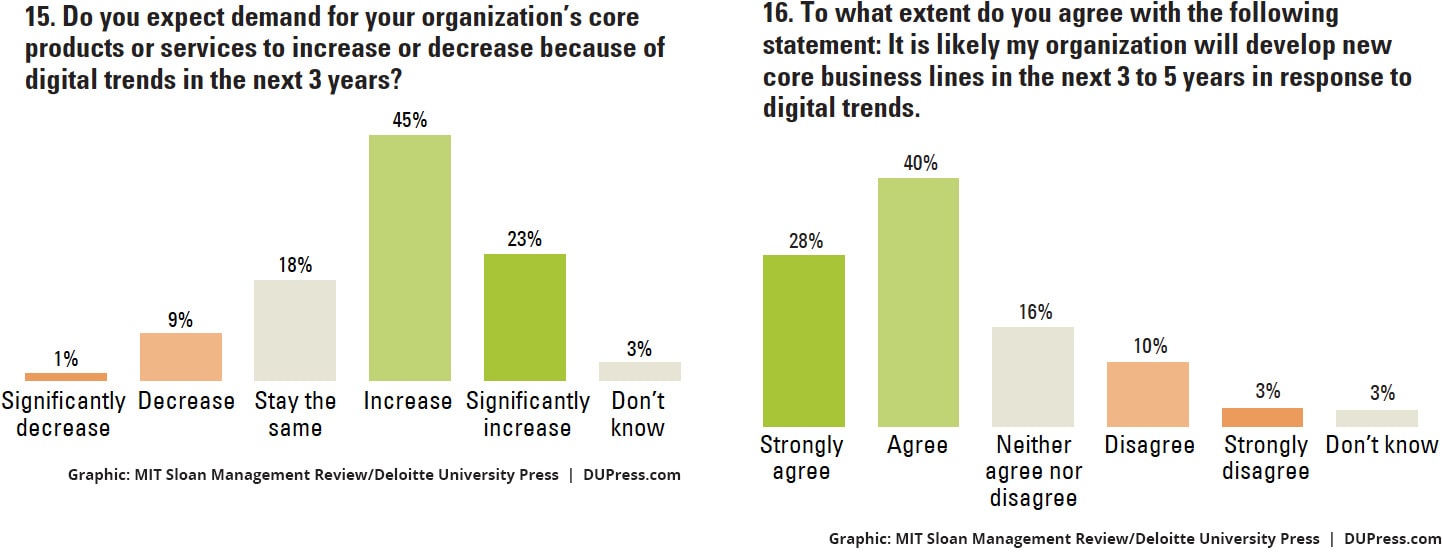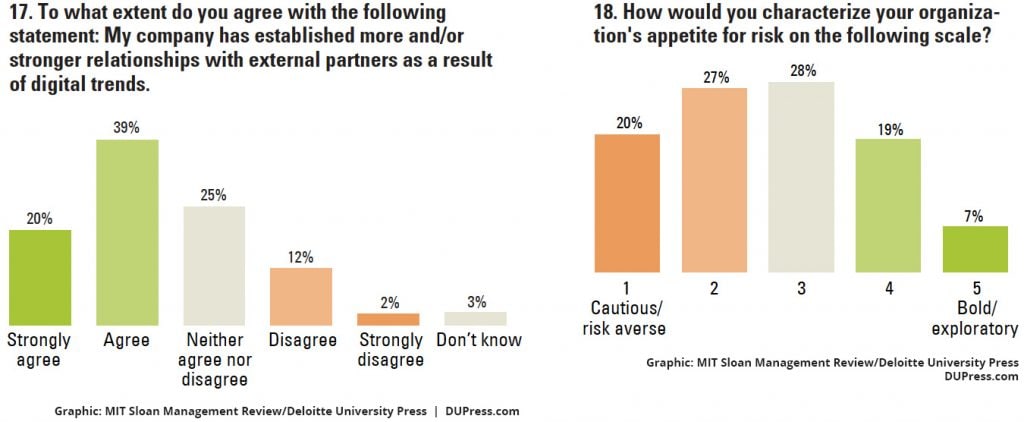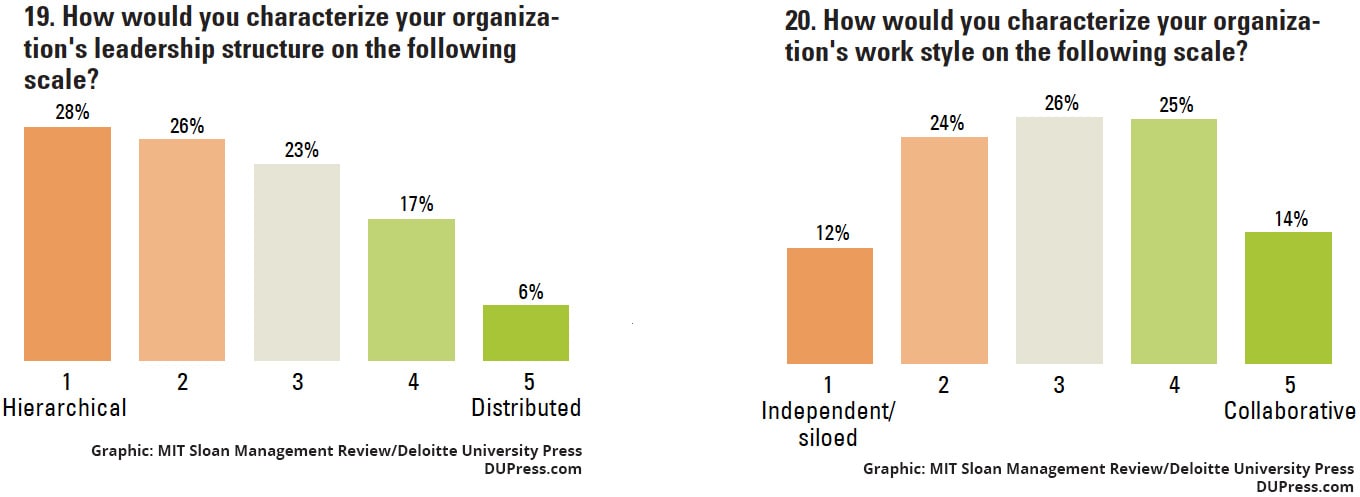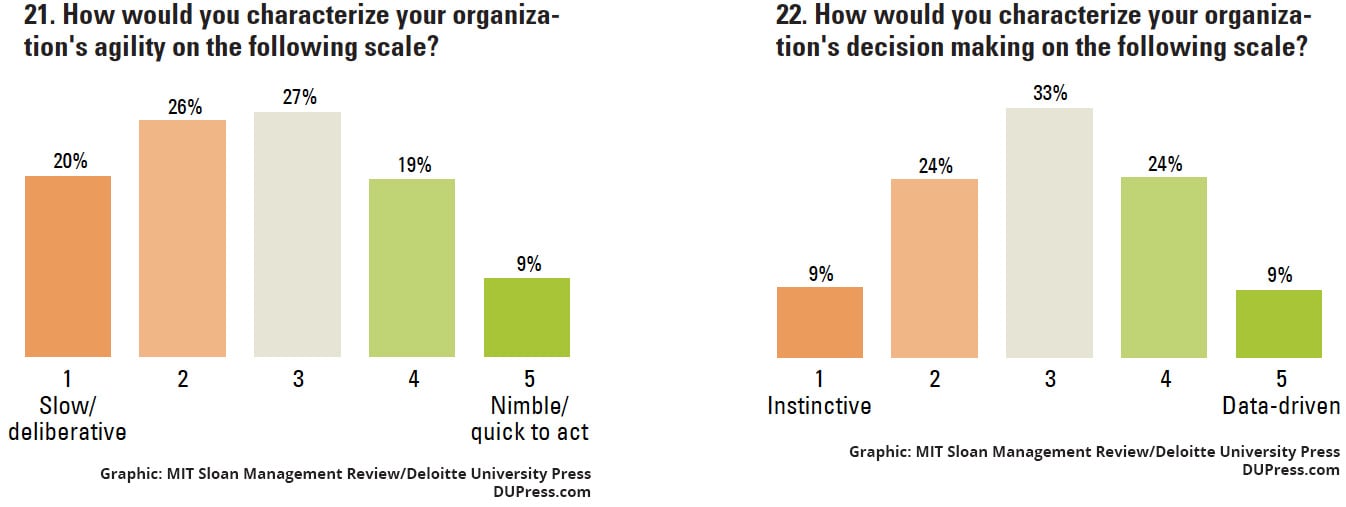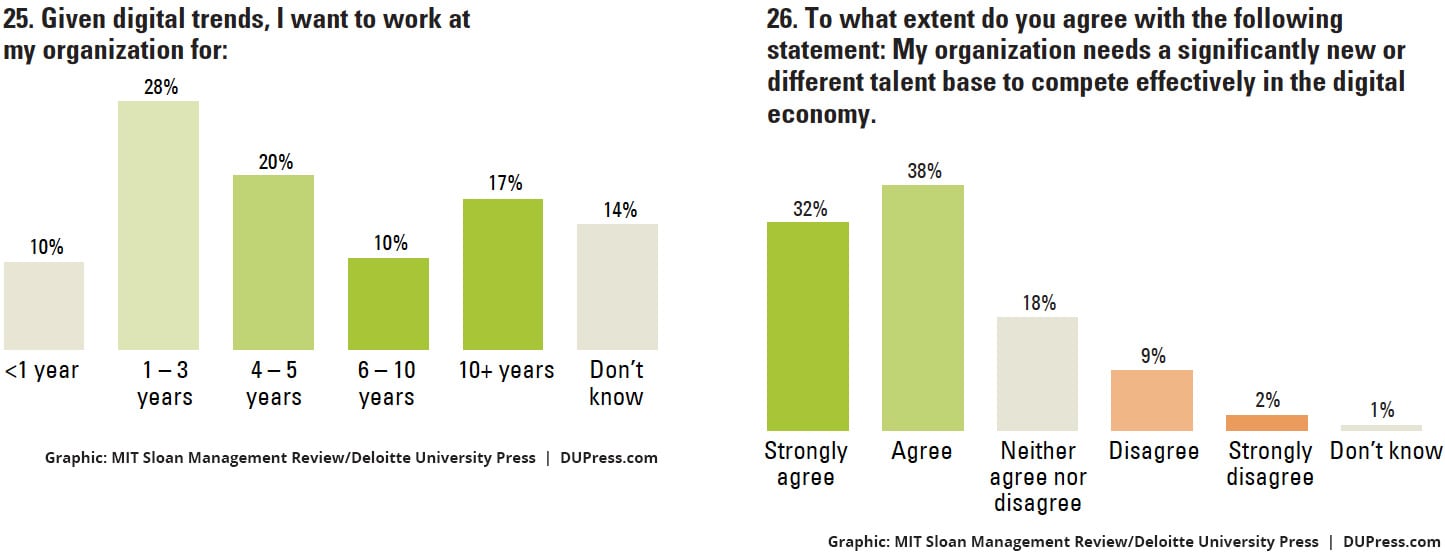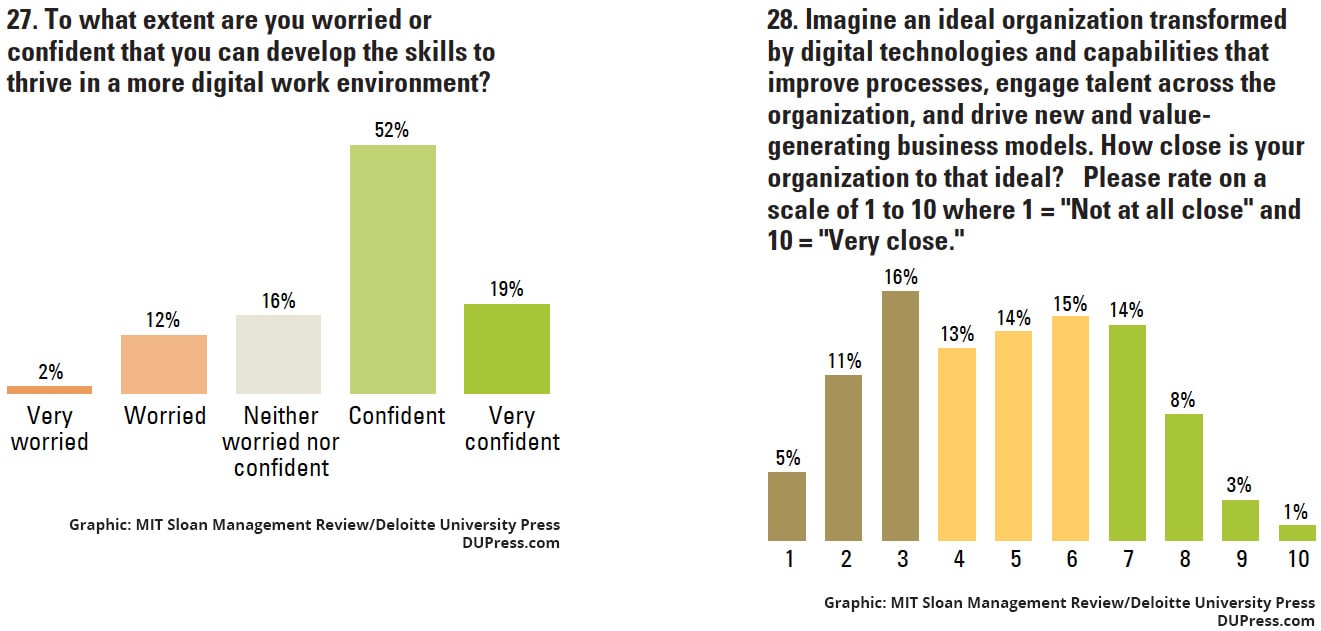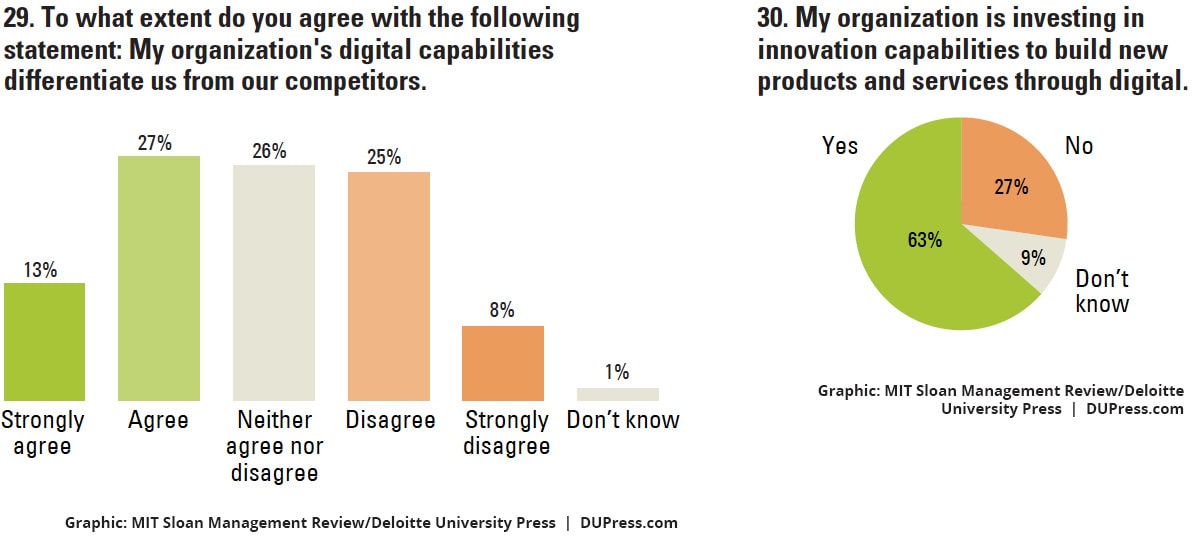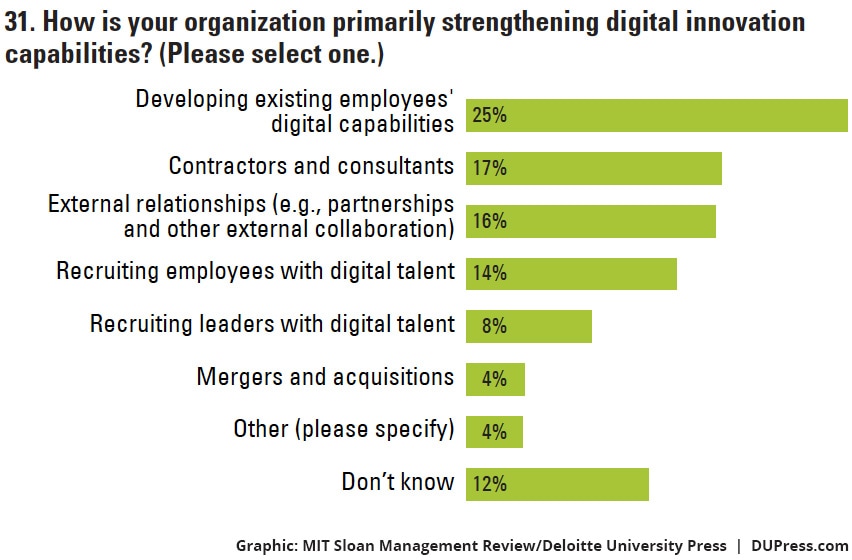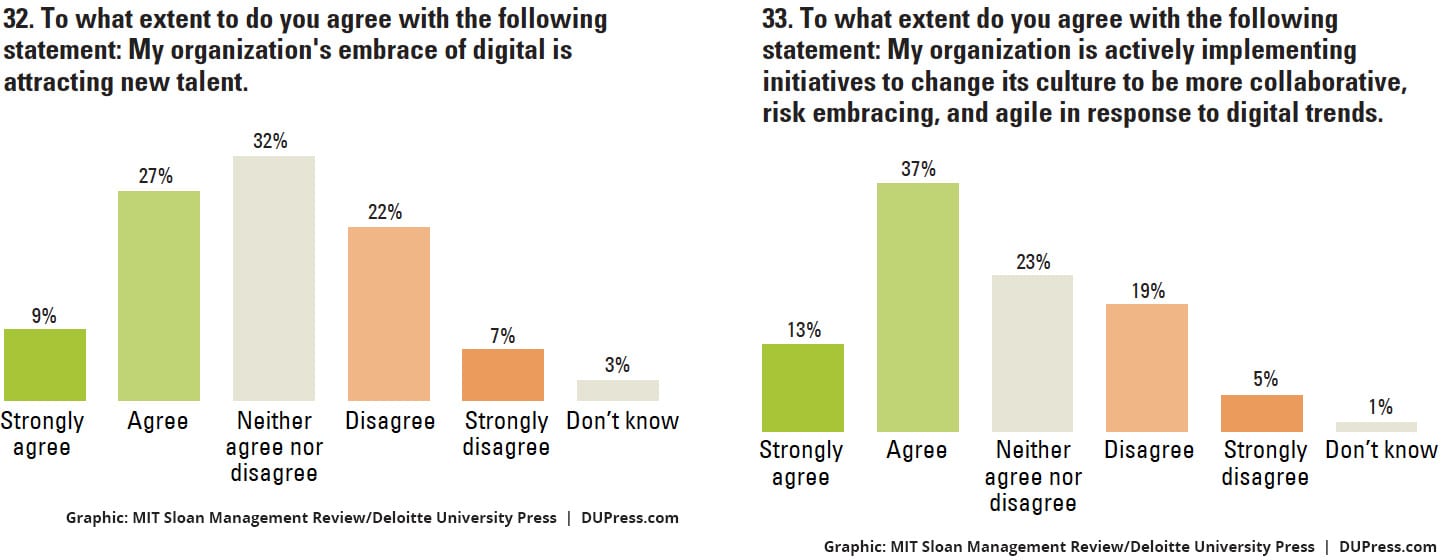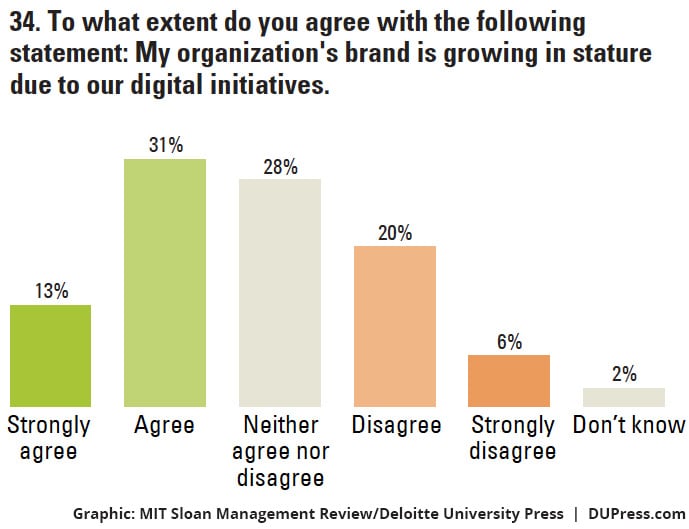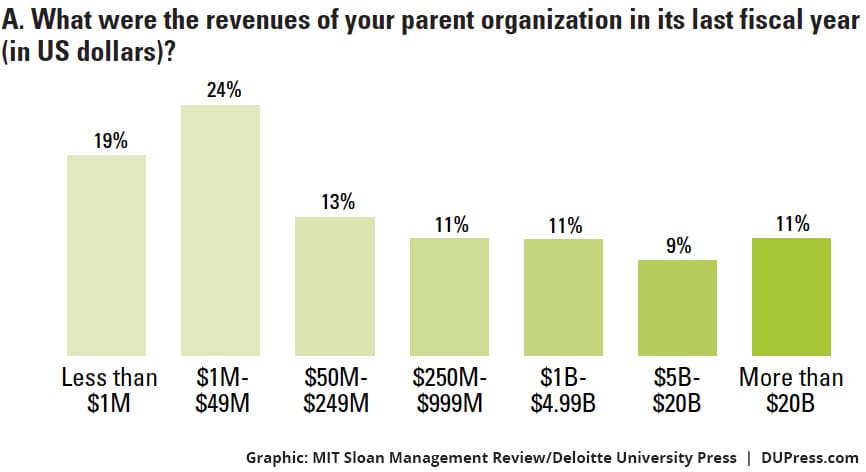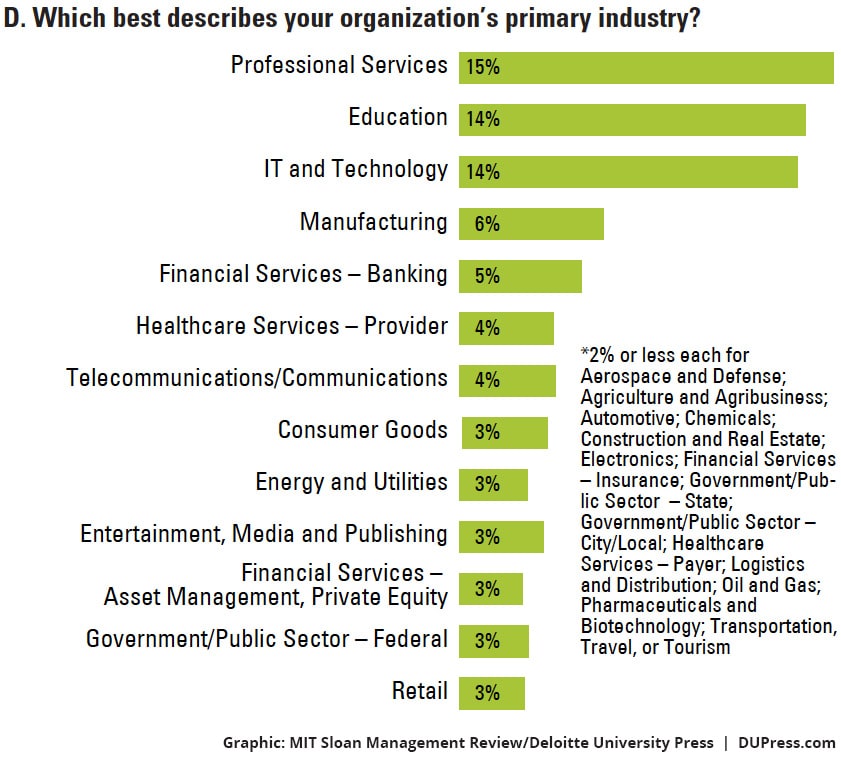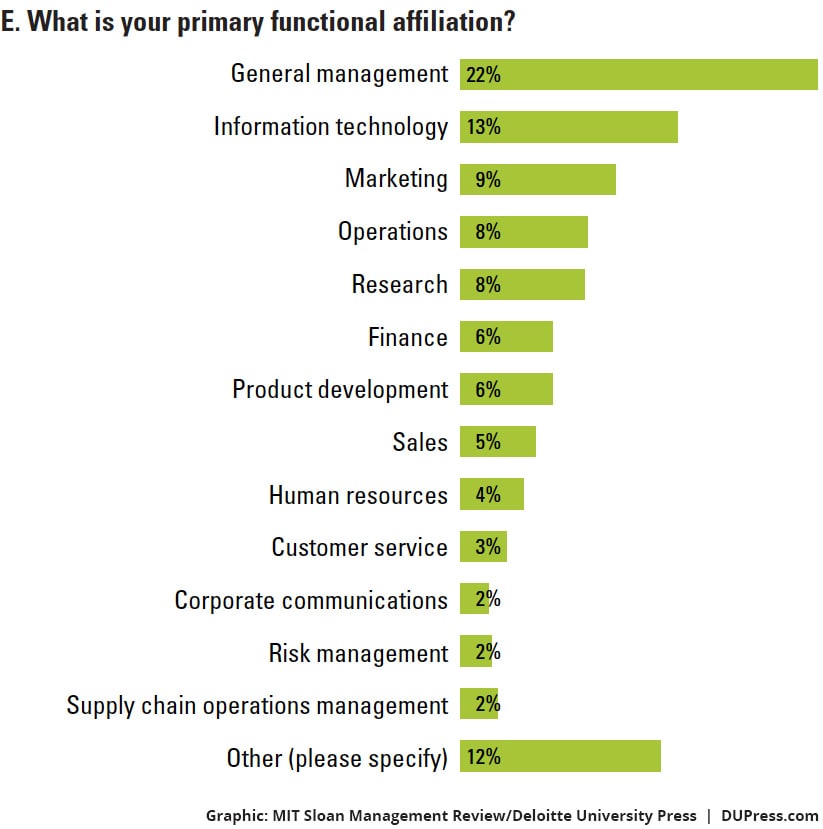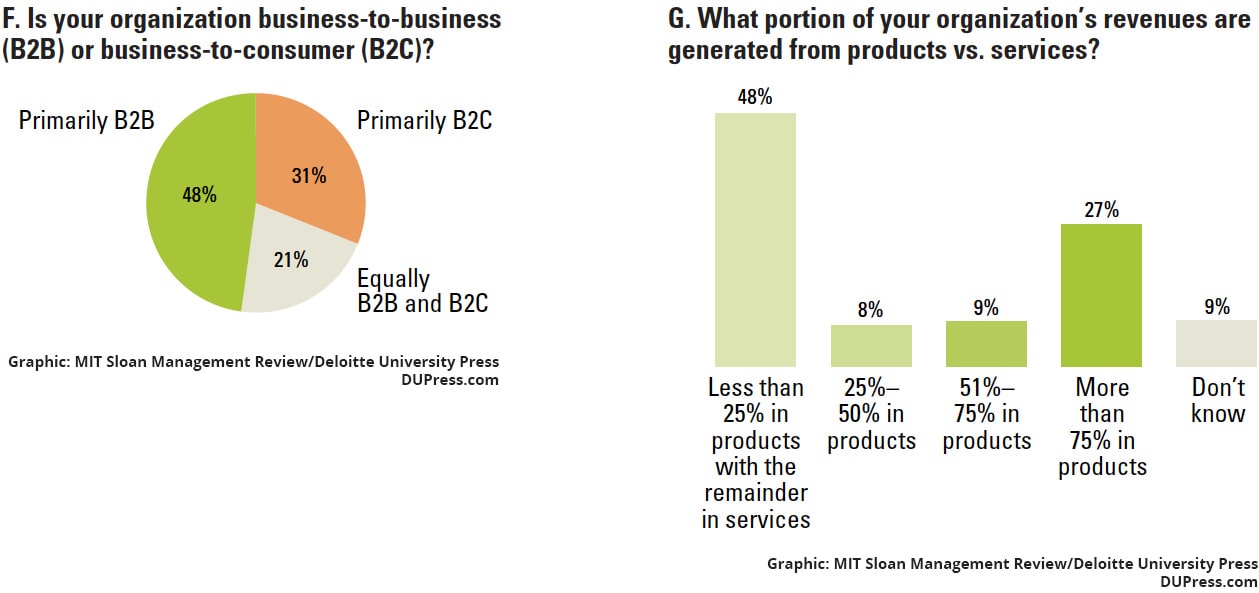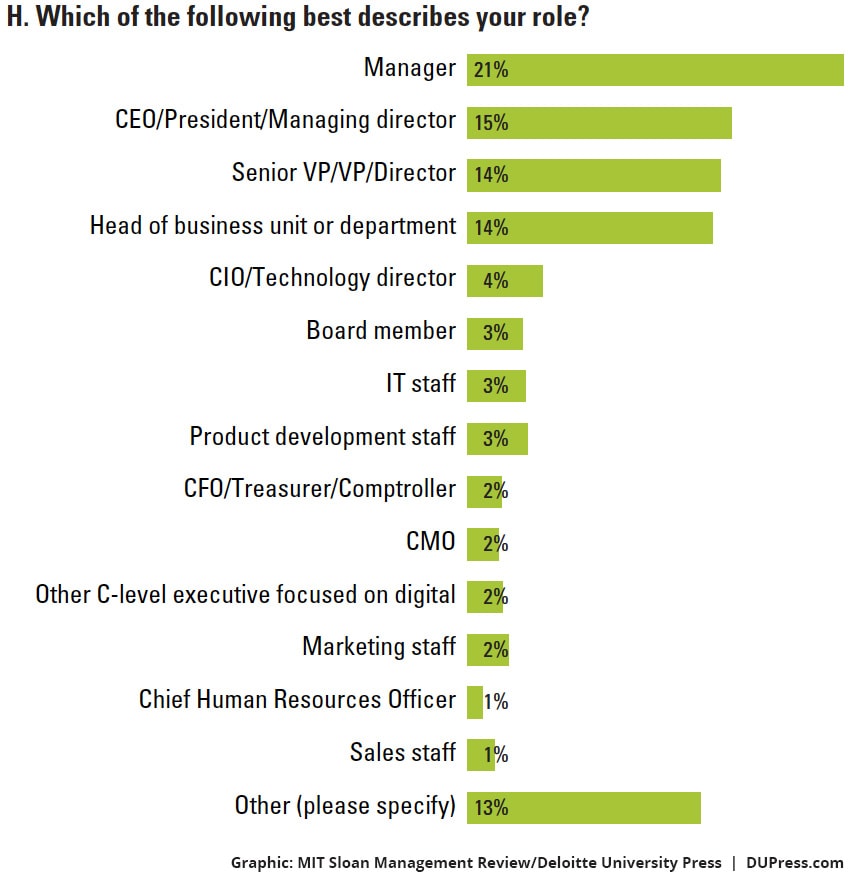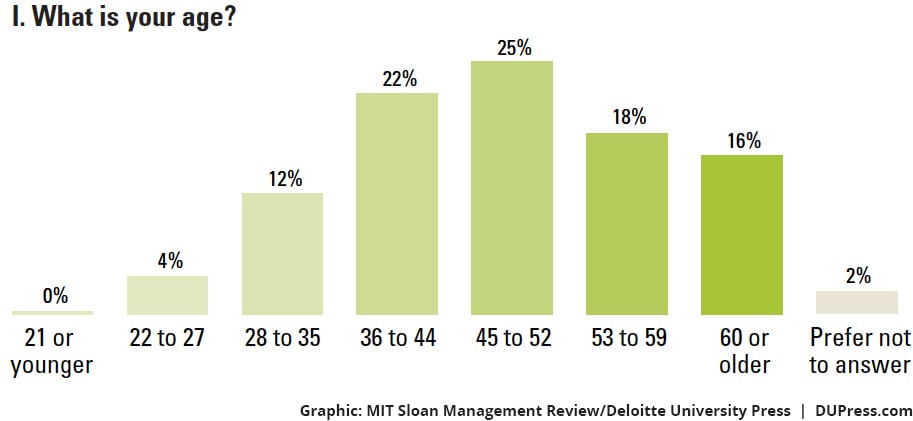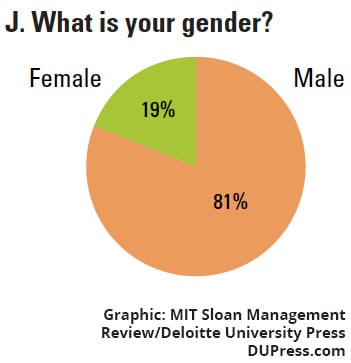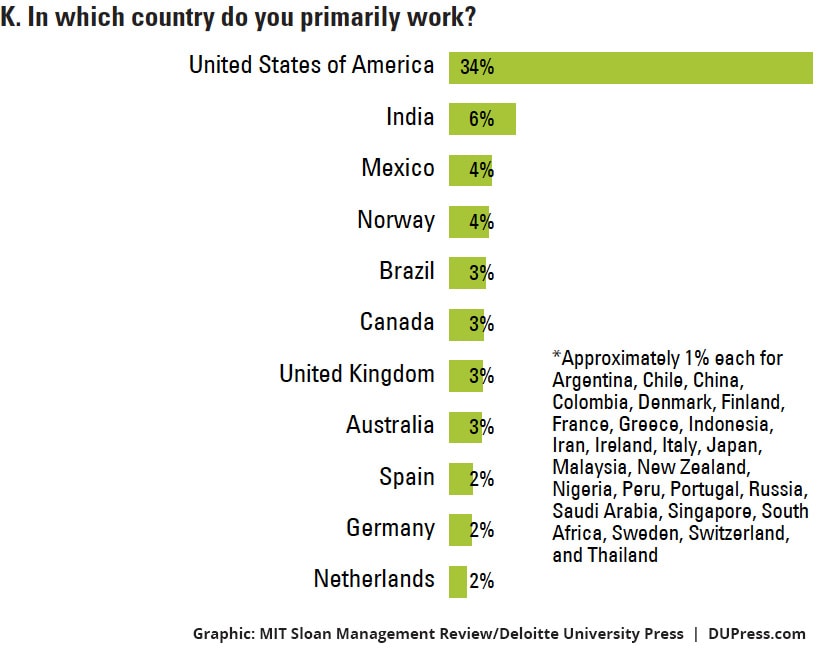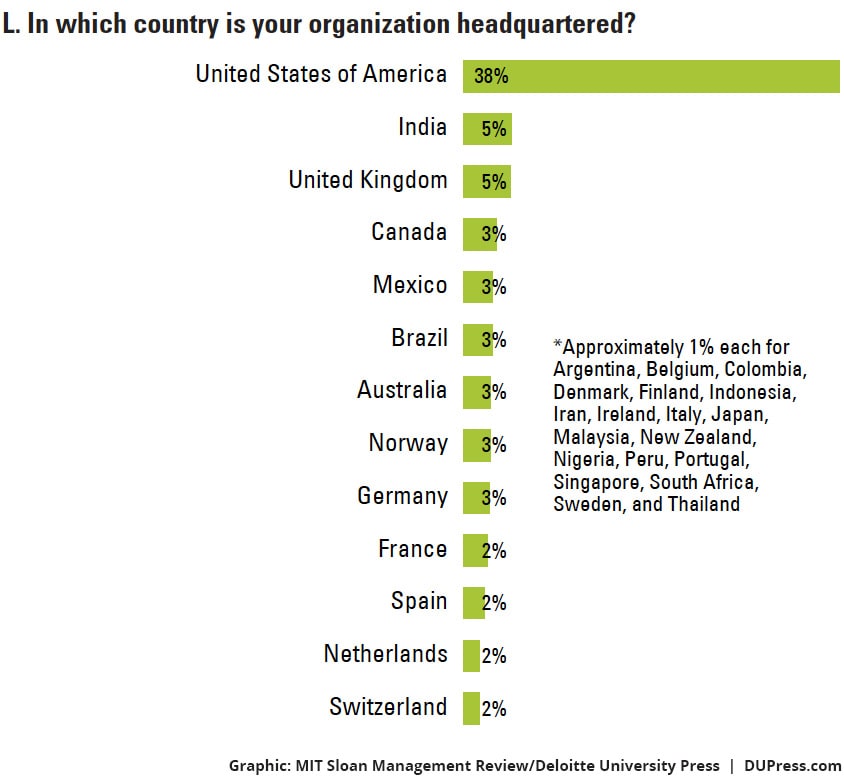Aligning the organization for its digital future has been saved

Aligning the organization for its digital future Findings from the 2016 digital business global executive study and research report
26 July 2016
Are you ready for a digital future? Nearly 90 percent of managers and executives surveyed expect “great” or “moderate” digital disruption, but fewer than half say their organizations are adequately preparing. Companies can take steps toward digital maturity, though—without necessarily putting technologists in charge.
Executive Summary
Many companies are responding to an increasingly digital market environment by adding roles with a digital focus or changing traditional roles to have a digital orientation. The list of “digital” business roles and functions is extensive and growing. There are now digital strategists, chief digital officers, digital engagement managers, digital finance managers, digital marketing managers, and digital supply chain managers, among other positions.
Despite the proliferation of digital roles and responsibilities, most executives recognize that their companies are not adequately preparing for the industry disruptions they expect to emerge from digital trends. Nearly 90% of respondents to a 2015 global survey of managers and executives conducted by MIT Sloan Management Review and Deloitte1 anticipate that their industries will be disrupted by digital trends to a great or moderate extent, but only 44% say their organizations are adequately preparing for the disruptions to come.
Preparing for a digital future is no easy task. It means developing digital capabilities in which a company’s activities, people, culture, and structure are in sync and aligned toward a set of organizational goals. Most companies, however, are constrained by a lack of resources, a lack of talent, and the pull of other priorities, leaving executives to manage digital initiatives that either take the form of projects or are limited to activities within a given division, function, or channel.
Despite this, some companies are transcending these constraints, achieving digital capabilities that cut across the enterprise. Our research found that nearly 90% of digitally maturing organizations — companies in which digital technology has transformed processes, talent engagement, and business models — are integrating their digital strategy with the company’s overall strategy. Managers in these digitally maturing companies are much more likely to believe that they are adequately preparing for the industry disruptions they anticipate arising from digital trends.
A key finding in this year’s study is that digitally maturing organizations have organizational cultures that share common features. These features consistently appear in digitally maturing companies across different industries. The main characteristics of digital cultures include: an expanded appetite for risk, rapid experimentation, heavy investment in talent, and recruiting and developing leaders who excel at “soft” skills. Leading a digital company does not require technologists at the helm.
To help companies better prepare for their digital futures, we delved into how digitally maturing organizations strengthen their cultures and develop the talent that drives them. Highlights of our findings include the following:
Creating an effective digital culture is an intentional effort: Digitally maturing companies are constantly cultivating their cultures. Nearly 80% of respondents from digitally maturing companies say their companies are actively engaged in efforts to bolster risk taking, agility, and collaboration. Only 23% of companies at the early stages of digital development are doing so.
Senior-level talent appears more committed to digitally maturing enterprises: Companies that give their senior vice presidents, vice presidents, and director-level leaders the resources and opportunities to develop themselves in a digital environment are more likely to retain their talent. In contrast, approximately 30% of such leaders who lack such opportunities are planning to find new jobs in less than one year.
Digitally maturing organizations invest in their own talent: More than 75% of digitally maturing organizations surveyed provide their employees with resources and opportunities to develop their digital acumen, compared to only 14% of early-stage companies. Success appears to breed success — 71% of digitally maturing companies say they are able to attract new talent based on their use of digital, while only 10% of their early-stage peers can do so.
Soft skills trump technology knowledge in driving digital transformation: When asked about the most important skill for leaders to succeed in a digital environment, only 18% of respondents listed technological skills as most important. Instead, they highlighted managerial attributes such as having a transformative vision (22%), being a forward thinker (20%), having a change-oriented mindset (18%), or other leadership and collaborative skills (22%). A similar emphasis on organizational skills above technical ones for succeeding in digital environments was also reported for employees.
Digital congruence is the crux: To navigate the complexity of digital business, companies should consider embracing what we call digital congruence — culture, people, structure, and tasks aligned with each other, company strategy, and the challenges of a constantly changing digital landscape. For example, a conservative and hierarchical organization populated with energetic entrepreneurs may not be able to harness their drive and energy. Similarly, an organization with a flat and nimble structure may still struggle if its culture fears risk. When culture, people, structure, and tasks are firing in sync, however, businesses can move forward successfully and confidently.
About the research
To understand the challenges and opportunities associated with the use of social and digital business, MIT Sloan Management Review, in collaboration with Deloitte, conducted its fifth annual survey of more than 3,700 business executives, managers, and analysts from organizations around the world.
The survey, conducted in the fall of 2015, captured insights from individuals in 131 countries and 27 industries, from organizations of various sizes. More than two-thirds of the respondents were from outside of the United States. The sample was drawn from a number of sources, including MIT Sloan Management Review readers, Deloitte Dbriefs webcast subscribers, and other interested parties. In addition to our survey results, we interviewed business executives from a number of industries, as well as technology vendors, to understand the practical issues facing organizations today. Their insights contributed to a richer understanding of the data.
Surveys in the first three years of this research collaboration were conducted with a focus on social business. This year’s study and last year’s expanded to include digital business.
Digital maturity was measured in this year’s study similar to how it was measured in prior years. We asked respondents to “imagine an ideal organization transformed by digital technologies and capabilities that improve processes, engage talent across the organization, and drive new value-generating business models.” We then asked respondents to rate their company against that ideal on a scale of 1 to 10. Three maturity groups were observed: “early” (1-3), “developing” (4-6), and “maturing” (7-10).
A hierarchical cluster analysis confirmed the composition of these maturity groups. The analysis revealed three distinct clusters of respondents who had similar answers to specific survey questions related to organizational structure and culture. Characteristics of the clusters related to culture, talent, and leadership align closely to those of the “early,” “developing,” and “maturing” groups noted above.
Introduction
When CVS Health Corporation recruits new leaders, it doesn’t emphasize digital skills. The pharmacy benefits manager and drugstore chain, based in Woonsocket, Rhode Island, doesn’t have a digital division or a senior executive presiding over a digital P&L. Yet in 2016, the organization’s digital capabilities helped it land on Fast Company magazine’s list of the most innovative organizations in the world.2
CVS’s tribute spotlights the key findings of this year’s research into digital business by MIT Sloan Management Review and Deloitte: Digital transformation has reached a new stage in which digital technologies aren’t limited to separate digital divisions, channels, or functions but are used across organizations to support corporate strategies that address specific industry opportunities. And digital leaders aren’t necessarily high-tech wunderkinds. Their main attributes are the ability to inspire, manage complexity, and develop distinct digital cultures conducive to success in rapidly changing environments.
At CVS, for example, digital strategy isn’t about creating a separate digital drugstore or channel. It supports the organization’s broad ambition of becoming a health care company with pharmacy services, retail stores, and health clinics. “We try to weave digital into every aspect of our business and business unit strategy,” says Brian Tilzer, senior vice president and chief digital officer. “Our goal isn’t to create a separate digital division. We are using digital technologies to create outstanding customer experiences.”
A surprising finding in this year’s survey is that although digital strategies differ by industry and circumstance, the cultures of digitally progressive companies share important characteristics: They engage in rapid experimentation, take risks, invest in their own talent, and value soft skills in leaders more than they do technical prowess.
Again, CVS illustrates. Rapid experimentation creates the company’s rhythm and provides the knowledge and solutions that keep it moving. Equally important, the company ups its digital game by hiring people with digital and e-commerce backgrounds and then teaching them the health care industry. To lead its digital endeavors, CVS seeks leaders who can inspire and manage complex, cross-functional efforts.
CVS Health is not an outlier — it reflects the hallmarks of digitally maturing companies. Our findings are based on an assessment of companies’ sophistication in their use of digital technologies. For the past two years, we have conducted surveys in which we asked respondents to “imagine an ideal organization transformed by digital technologies and capabilities that improve processes, engage talent across the organization, and drive new value-generating business models.” (See “About the Research.”) We then asked them to rate their company against that ideal on a scale of 1 to 10. Respondents fall into three groups: companies at the early stages of digital development (rating of 1-3 on a 10-point scale, 32% of respondents), digitally developing companies (rating of 4-6, 42% of respondents), and businesses that are digitally maturing (rating of 7-10, 26% of respondents). (See Figure 1.)
Our analysis discovered how digitally maturing companies are embracing digital transformation and what sets them apart. In this report, we look at the nature of the gap between the digitally maturing and early-stage companies and share insights on how advanced companies continue to pull ahead.
Threats Abound, and Talent Is Ready to Flee
That digital technologies will disrupt practically every industry has become a given: Nearly 90% of respondents believe it will happen in their sector. (See Figure 2.) However, a significant majority of business leaders say digital technologies are primarily an opportunity. In last year’s survey, for example, only 26% of respondents said that digital technologies presented a threat of any kind.
John Hagel, co-chairman of the Center for the Edge at Deloitte, believes failing to recognize the threat is risky. “There is tendency to see digital technology as an opportunity or choice,” he observes. “However, the mounting pressures of a rapidly shifting business landscape are turning digital from a choice into an imperative. The longer a business waits, the more marginalized it will become.”
Our survey found that the majority of companies may be waiting too long. Only 44% of respondents overall say their organizations are adequately preparing for digital disruption. On the part of early-stage companies, the number drops to 15%. In contrast, 78% of respondents from maturing organizations — more than five times the proportion of early-stage respondents — say their companies are adequately preparing.
The Peril of a Physical-World Mindset
Arun Sundararajan, a professor of business at New York University and author of The Sharing Economy, attributes the lack of preparedness to a physical-world mindset. “Many business leaders still believe that if your product exists in the physical world, you can’t be digitally disrupted,” he says. “That’s the wrong attitude. Any responsible company today should view digital technologies as a means to create a more efficient organization or a different form of customer engagement, irrespective of how physical the product may be.”
Even the restaurant industry, with its physical locations and products, faces digital disruption. Digital ordering pioneer Olo, for example, provides a digital platform and delivery service for restaurants that allows customers to order directly from their favorite spots. The New York City-based company provides analytics to help restaurants shift delivery areas based on current traffic patterns and prepare meals at optimal times to ensure freshness. The implications of Olo’s products, however, are more than increasing convenience and efficiency — these digital technologies may fundamentally reshape the restaurant industry. For example, if restaurants can optimize delivery logistics, then they can locate where real estate is less expensive. They can even have restaurants that are just kitchens with no onsite dining options.
When pressed on the issue of digital threats, many business leaders can identify some internal and external examples. Responding to an open-ended question about digital threats, the top concern cited by respondents is internal issues such as lack of agility and cultural complacency (19%), suggesting that companies may be holding themselves back. Market disruptions, including product obsolescence (17%) and competitive pressure (16%), ranked second and third. Security issues came in fourth, with 14% saying it is a top agenda item. (See Figure 3.)
Employees and Executives are Paying Attention to Digital Trends
Talent flight is a major threat that isn’t on the radar — a scant 6% of respondents say that recruiting and developing digital talent is their No. 1 concern. However, our study found that significant numbers of employees and executives are ready to leave companies that aren’t keeping pace with digital change.
At companies in the early stages of digital development, for example, more than 50% of employees who responded say they are planning to leave their organizations in less than three years. More than 20% plan to be gone within one year. At digitally maturing companies, on the other hand, only 25% of employees expect to be seeking greener pastures in the next three years, and only 4% have plans to leave within a year. While there are many possible reasons why employees want to leave an organization, digital development may be a useful indicator of talent flight risk.
The looming exodus isn’t only on the part of millennials or junior-level employees. Approximately 30% of senior vice presidents, vice presidents, and director-level leaders surveyed who don’t have adequate access to resources and opportunities to develop and thrive in a digital environment are planning to leave their company in less than one year. (See Figure 4.)
Talent is leaving at the same time that it is in short supply. Only 11% of respondents overall say that their company’s current talent base can compete effectively in the digital economy. On the part of maturing companies, the number rises to just 20%.
Dan Restuccia, chief analytics officer at Boston-based Burning Glass Technologies, a job market analytics firm, argues that companies need to build talent supply chains using the same expertise they use when managing the supply chains of goods and materials. Doing so will enable companies to identify talent needs in advance and then address any potential disruptions to or inefficiencies in the flow of talent. “Very few firms are able to forecast the talent they’re going to need and then take proactive steps to build, develop, and find that talent,” he says. “Most companies acquire talent on the ‘spot market,’ like commodities, and may have to pay a premium for employees and then spend months training them.”
Businesses can overcome these hurdles and thrive in a digital environment. They can develop their own talent as well as hire new talent. Examples increase every day of large and established companies that are using digital technologies to revamp how they do business. Their ranks span the gamut from industrial giant General Electric Co. — which is expanding from industrial equipment to software-enabled industrial solutions and revamping its talent strategy3 — to Adobe Systems Inc., which is shifting much of its service offerings to the cloud and changing everything, from offering constant product innovation to enhancing customer experiences.
Digital Strategy — An Industry Take:
Respondents were asked to select the technology most important to their organization today and in three to five years. Values noted represent the percentage of respondents in an industry who chose that technology as the most important to their organization today. Heat map colors reflect the change in percentage of respondents selecting that technology as most important today versus in three to five years. For example, 47% of respondents from the insurance industry indicated that analytics is the most important technology in their industry today. However, the percentage of respondents from that industry citing analytics as being most important three to five years from now declined, while the percentage of respondents saying the Internet of Things would be the most important technology grew.
Digital Strategies: Unique and With a Long View
Digital strategies are unique to organizations and the industries in which they compete. This is evident when looking at the different technologies that are most important to companies today and in the next three to five years. For example, nearly 30% of IT and technology respondents cite analytics as the most important technology to their company today, while mobile is the technology cited most often by banking respondents as most important, at 39%. Looking ahead three to five years, IT and technology respondents expect a significant increase in focus on the Internet of Things and cognitive technologies, while banking respondents expect a significant increase in focus on social technologies. (See “Digital Strategy — An Industry Take.”)
Increasingly, digital strategies are supporting broad company goals. As is the case with CVS, nearly 90% of digitally maturing companies surveyed tie their digital strategies closely to their company’s overall strategy. Only 38% of early-stage companies make the same connections. (See Figure 5.)
Digitally maturing companies also take a longer-term view of strategy compared to early-stage companies — more than 50% of respondents from digitally maturing companies create strategies with time horizons greater than two years, compared to 34% for early-stage companies. Even so, only 4% of maturing organizations create digital strategies with time horizons of more than 10 years.
Time frames greater than 10 years may be needed to be effective in a digital environment, according to the Center for the Edge’s Hagel. He advocates that businesses create strategies with 10- to 20-year time horizons in order to understand how their industries and markets will change and what they need to do to be prepared. To address the digital future while meeting today’s needs, he suggests that organizations use the zoom-out/zoom-in approach used by many Silicon Valley companies. The zoom-out dimension looks at a time horizon of 10 or more years by predicting and defining what the market will look like and what customers will expect. The zoom-in component addresses the next six to 12 months and identifies the two or three business initiatives that will have the greatest potential to accelerate movement toward the longer-term destination.
This is not to say that predicting digital trends on long time horizons is straightforward. Nonetheless, certain technologies are likely to become ubiquitous, and companies need to be cognizant of them and their implications. Consider driverless cars. Although it may not be clear when these might become the order of the day, driverless cars will have a significant impact on a number of sectors. Rather than buy their own, consumers may turn to Uber Technologies Inc. and similar companies that own and dispatch cars, which will significantly change the customer base for auto dealers. Similarly, if Uber-like companies are the primary market for driverless cars, auto manufacturers will need to focus on different designs, such as multi-passenger cars for mass transportation and/or vehicles designed to carry only one person.
When taking a long-term view, it is also important to avoid what Richard Gingras, senior director of news and social products at Google Inc., calls competency traps. “It is very easy for companies to find solace in what they have been doing and be reluctant to consider how to change it,” he says. “It’s much easier to start with a clean slate and build from there. Organizations need to look at the market and its opportunities instead of taking an existing product or business model and trying to make it fit a new environment.”
Some businesses are seeking to escape this trap and progress to the next generation of their digital strategies. Many major retailers, for instance, are attempting to move beyond their initial e-commerce forays, when they tried to compete directly with Amazon.com Inc. Now they are moving into high-touch product categories where they can differentiate themselves through effective in-store and online customer experiences.
Culture and Talent Are at the Helm
Our survey found that organizational cultures don’t vary as much as digital strategies, which can vary considerably from one organization and industry to another. By contrast, companies at early, developing, and maturing levels have cultures that are similar within each level of digital maturity.
To understand what a digital culture looks like, we asked respondents to assess multiple components of their organization, including their appetite for risk, leadership structure, work style, level of agility, decision-making approaches, and passion for work.
Our analysis found three distinct cultural mindsets that relate closely to stages of digital maturity. (See “About the Research.”) The first mindset is common among early-stage digital organizations and is characterized by a low appetite for risk, a hierarchical leadership structure, work performed in silos, and decisions based more on instinct than on data. Conversely, cultural mindsets that relate closely to digitally maturing companies value experimentation and speed, embrace risk, and create distributed leadership structures. They also foster collaboration and are more likely to use data in decision making. In the middle are cultures en route from the first group to the third. (See Figure 6.)
Creating Effective Digital Cultures
Digitally maturing companies are constantly cultivating the characteristics mentioned above. Nearly 80% of digitally maturing entities surveyed are actively engaged in initiatives that will bolster risk taking, agility, and collaboration. On the part of their early-stage peers, the number falls to 23%.
Developing a digital culture may require significant shifts in corporate behavior, according to Google’s Gingras. “If you look at the history of corporate culture, you see that it’s about improving efficiency, increasing margins, and eliminating risk,” he says. “But none of this works in the world of the Internet, where things change so incredibly fast.”
As a result, digitally maturing companies surveyed place a strong emphasis on innovation and are over twice as likely to be investing in innovation than are early-stage entities — 87% versus 38%. More than 80% of digitally maturing companies plan to develop new core business lines in the next three to five years in response to digital trends. Only about half of early-stage companies have similar plans.
At CVS, for example, innovation and experiments are the pulse of the company. “We invest in innovations with a small ‘i,’ such as what you can do to improve the customer experience tomorrow, and also in innovations with a capital ‘I’ that are more transformational,” says Tilzer. “We think of the impact of these innovations in three time zones: this year, in one to three years, and then beyond three years.”
The company’s Digital Innovation Lab experiments with technology to pave the way for bold efforts in the future, such as a partnership with IBM Watson to use artificial intelligence to help consumers identify their health risks. But the lab also addresses pain points that customers have today. ScriptSynch, for example, is an app that lets customers manage the timing and delivery of prescription refills, while the CVS Express app allows customers to place orders online and have the merchandise brought to their cars.
Cultivating Digital Talent and Leaders
Talent development is an important element of the culture at digitally maturing organizations, which place a decisive emphasis on developing existing talent and recruiting new talent — 76% of respondents from digitally maturing companies say their companies provide resources and opportunities to develop digital acumen. However, only 14% of employees at early-stage companies and 44% at developing companies say that their organizations do. (See Figure 7.) Not surprisingly, 71% of employees at maturing companies say their organization’s employees have sufficient knowledge and ability to execute their organization’s digital strategy. Only 22% of respondents from early-stage companies make the same claim.
Digitally maturing companies are also significantly better able to attract new talent based on their use of digital — 71% of respondents from digitally maturing companies say so versus only 10% of those from early-stage organizations, which tend to rely on contractors and consultants to support their digital efforts. As a result, a talent gap is developing for early-stage companies. While these companies need digital talent to help them advance digitally, their lack of progress restricts their ability to bring in that talent.
San Francisco-based Salesforce.com Inc. provides the resources and opportunities for its employees to thrive in a digital environment. The cloud-computing company drives continuous learning and skill development through an online platform offering courses that cover its products and particular jobs and roles. When employees complete a course, they receive a badge. But the badges are more than token rewards. The badges also appear in the employee’s profile on the company’s internal social collaboration site, which helps employees identify people in the company with specific expertise and can be used as part of an employee’s performance evaluation.
Cancer Treatment Centers of America Inc. is another example. The for-profit hospital network, headquartered in Boca Raton, Florida, offers a mix of in-person, online, and on-demand digital-skills training that fits the schedules and work realities of its busy medical professionals. According to CIO Kristin Darby, a key component is “at-the-elbow” training. “We will do personal training with physicians anywhere from 6:30 in the morning to 8:00 at night,” she says. “We make sure our trainers can be there when it’s most appropriate for our doctors.” When indispensable employees don’t have the time to come to training to develop the necessary skills to operate in an increasingly digital health care environment, the company takes the training to them.
When developing employees for success in digital environments, business leaders place a greater emphasis on change skills than on technology knowledge. In an open-ended question, we asked respondents which employee skills were most central to success in a digital workplace. A change-oriented mindset (e.g., willing to embrace change, be flexible, adaptable, and curious) emerged as the most important (38%), followed by digital and technology literacy (27%), and strategic thinking (16%). “Companies are looking for people who have a balance of technical and soft skills,” says Restuccia of Burning Glass Technologies. “Today, people with deep technical knowledge are expected to have solid skills in areas such as communication.”
The balance becomes especially clear when looking at the STEAM movement, which advocates adding art to the traditional STEM stack of science, technology, engineering, and math. Restuccia observes that new jobs are emerging that require both technology and liberal arts backgrounds, such as user-experience designer. “This job is one part designer and one part psychologist,” he says. “When companies are looking for user-experience designers, many will seek candidates with degrees in psychology or anthropology.”
Digitally maturing companies also place a premium on leadership. More than 80% of respondents from digitally maturing organizations say their leaders have sufficient knowledge and ability to lead the company’s digital strategy. Only 22% of early-stage business respondents have the same belief.
Technology knowledge is not the most important skill leaders need to have. In an open-ended question, respondents said that the ability to steer a company through business model change is the most important skill, cited by 22%. Being a forward thinker is almost as important, with 20% of respondents placing it in the top spot. (See Figure 8.)
Tales from the Field — Putting Digital Culture and Talent to Work
Adobe: Combining Employee and Customer Experience
In 2012, Adobe undertook a major overhaul of its business: It shifted from software shipped in shrink-wrapped boxes and sold through long-term licenses to a subscription model in the cloud with lower monthly fees designed to attract a larger portion of the market. The company also added digital marketing to its portfolio, expanding from its traditional focus on the graphic design and publishing industries.
Adobe’s senior management realized the importance of culture, talent development, and employee engagement in making such fundamental changes to its structure and business model. Although the company gained new digital talent through a series of acquisitions, Adobe’s leaders strongly believed that culture and talent development efforts had to be fused more strongly. To foster that connection, the company took the bold step of putting employee and customer experience under the same organizational umbrella and leader.
“We have had a long-standing commitment to investing in our employee experience,” says Donna Morris, executive vice president of customer and employee experience. “But we felt we needed to change our culture and put the same emphasis on customers. We wanted all employees to share the common perspective that they do contribute to the customer experience.”
As an example of the combination, Morris points to Adobe’s Experience-a-thon program. Designed to put employees in their customers’ shoes and spur change, the program turns employees into product users who provide immediate feedback to the customer organization, in this case Adobe itself. “There is such an opportunity to have our employees experience our products and services firsthand before we offer them to customers,” she says. “By combining employee and customer experiences, we are able to create rich customer experiences through high levels of employee engagement.”
Salesforce.com — Culture Is Intentional
Salesforce grapples with the cultural challenges that every startup faces when it grows — retaining the values and beliefs that were its essence at its founding. Salesforce preserves its digital culture through calculated efforts. “We’re very intentional with our culture,” says Jody Kohner, vice president of employee marketing and engagement. “Culture is not something that happens to us.”
Being intentional about the culture starts with an emphasis on ‘ohana, the Hawaiian cultural value of extended family. “The concept is about an extended group of people that are bound together and responsible for each other,” says Kohner. “We reinforce that sense of family from day one through actions, programs, and initiatives.”
Building trust and empowering career advancement are also intentional elements of Salesforce’s culture. For example, to maintain and enhance its culture, the company asks employees for candid feedback and makes sure that they feel comfortable about being honest. The trust the company builds translates to other values such as empowering employees in their careers. “Silicon Valley is famous for people leaving for other companies,” she says. “Our leaders and managers explicitly encourage employees to raise their hands when they want a new challenge. That helps us identify development opportunities and supports a culture of honesty, since there is no retribution for saying what you feel.”
Slack — Building Culture in a Fast-Moving Environment
When it comes to building a culture for a digital environment, Slack Technologies Inc., the messaging software platform based in San Francisco, doubles down on the effort to make sure it can keep pace. In a fast-moving environment, company culture is what Slack’s chief marketing officer Bill Macaitis says keeps him up at night. To fortify the company’s culture, Macaitis relies on three principles:
- Hire for it: Slack’s hiring process screens for all its core values. “When we hire people, we look at how empathic and courteous they are, along with evidence of their craftsmanship,” he says. “When we make an offer, we are confident that the candidate aligns with our values.”
- Rally around it: Slack reinforces the culture of empathy by embracing an “everyone does support” ethos. Designers, developers, and product managers work alongside customer support agents to answer support tickets. This helps build empathy as the people building the product hear firsthand about the problems existing customers have.
- Live it: “We’ve written our values on the walls,” says Macaitis. “But as the old saying goes, it’s not just what you write, it’s what you do. You have to lead by example and provide ample training. That is what we are trying to do.”
Leading Into the Future
In the early 1980s, David Nadler and Michael Tushman spearheaded the idea of organizational congruence as a primary ingredient for optimal corporate performance.4 The concept is that only when the essential components of a business — its culture, people, structure, and tasks — are tightly aligned can the company achieve powerful results. For example, a conservative and hierarchical organization that recruits energetic entrepreneurs may not be able to harness their drive and energy. Similarly, an organization that has completely flattened its structure may still struggle if its culture shuns risk.
At first blush, the elements of congruence may seem intuitive, or even old hat. But in a constantly changing digital landscape, the concept of congruence gains new meaning and currency, since many companies fail to ensure that all of the organizational elements are firing together over time. “I’m often surprised by how detached executive management is from the actual culture of their companies,” says Chip Joyce, co-founder and CEO of Allied Talent LLC, a Silicon Valley-based boutique management development consultancy. “C-level executives often portray their organizations as transparent, open to risk taking, and having high morale. But as you move down the organizational structure, managers rarely believe it and say that the level of trust is very low.”
To navigate the complexity of digital business, companies should embrace what we call digital congruence — culture, people, structure, and tasks aligned with each other so that executives can effectively address the challenges of a constantly changing digital landscape. (See Figure 9.) To conclude, we explore how executives are creating congruence for a digital age and driving substantive change across their organizations.
Culture — Embracing Risk
Getting an organization to embrace risk goes beyond admonitions that taking risk is acceptable. Digitally maturing organizations build risk taking into the fabric of how they manage. “We have had to go through a learning exercise in terms of setting expectations,” says CVS’s Tilzer. “We now talk about experiments as a portfolio and don’t focus on things that don’t work. By design, every experiment isn’t going to pan out and result in something that works in the market.”
The U.S. Department of Agriculture’s Risk Management Agency monitors the cost growth of digital initiatives as an indicator of experimentation. CIO Chad Sheridan believes that if overall development cost growth is too low, then the organization’s exposure to risk may be increasing because adequate experimentation and learning aren’t taking place. “I’m building failure into my programs,” he says. “We plan and budget for the expected downside of our digital investment portfolio to support the expected failure inherent in any program of experiments.”
People — Deepening the Company’s Skills
As our survey results show, digitally maturing companies are more than five times more likely to provide employees with the opportunities to develop needed digital skills than are early-stage companies (76% versus 14%). Early-stage companies, by contrast, rely on consultants and contractors. Although this may be an excellent means to support efforts early on, relying solely on outside help should only be a stop-gap measure. The shortage of talent will continue to increase, and employees and executives who don’t feel they are gaining digital skills will seek their fortunes elsewhere — sooner rather than later. (See Figure 10.)
Digitally maturing companies do more than offer training courses. As we pointed out earlier, Salesforce.com combines customized online learning with badges that play a central role in performance evaluation and promotions. However, Hagel at Deloitte’s Center for the Edge argues that traditional training courses may be too limited. “With the mounting performance pressure and the accelerated pace of change that digital technology is bringing about, the most powerful form of learning is not accessing what other people already know,” he says. “It’s driving new knowledge creation through practice in the workplace itself, rather than in a training room.”
Allied Talent’s “tours of duty” are a prime example. A tour of duty is designed to deepen employee skills while engaging employees in creating their career paths.5 A typical tour lasts for two to four years and is focused on specific goals that support both the corporate mission and the employee’s career. Managers are committed to developing employee skills needed to complete the tour and then discuss additional tours of duty based on both the company’s needs and the employee’s career goals.
Structure — Nimble and Agile
Hierarchical leadership structures were designed for complex organizations in more stable times. To become more nimble and foster collaboration, some large organizations are simplifying their structures. For example, although Adobe is growing globally, it actually reduced its number of locations. “It was a deliberate decision to ensure employees could work together in close proximity,” says Morris. “Close collaboration is a prerequisite to scaling the business.”
Some organizations are turning to cross-functional teams to become more agile and letting formal structures fade into the background or disappear altogether. Visa’s marketing organization is a case in point. As the global payments industry evolves and established technology companies such as Apple Inc. and Google — and new entities including Bitcoin — enter it, Visa needed to match the speed of the industry. It did so by shifting from a vertical departmental structure to a horizontal and project-based approach. “We had to make the organization flatter and more fluid,” said Lara Balazs, senior vice president and head of North American marketing, in a 2015 Harvard Business Review report. “To do that, we moved to a model where people of different backgrounds move from project to project in a very fluid and agile way.” Marketing teams, for example, include expertise in marketing operations, digital content, analytics, traditional media, and online communities. The marketing teams work closely with product development and operational teams to ensure seamless execution of plans. As Balazs put it: “Horizontally connected teams drive speed, agility, and nimbleness.”6
Flat, agile organizations don’t have to become free-for-alls. Senior leaders can set high-level guidelines that local business units and functions can then apply. Consider one global conglomerate engaged in shipping, logistics, and the oil and gas industries. When developing social media marketing campaigns that touched on controversial environmental issues, senior leaders set global standards and objectives to guide the campaigns and online discussions. The company then allowed regional and local markets to tailor the ideas to their issues and needs.
Tasks — Contingent Workforces and Customized Work
Complex and lengthy recruitment and vetting processes for permanent and contingent labor won’t be able to keep pace with all talent needs in rapidly changing environments. Often, the best talent isn’t within the four walls of an organization, and not everyone is seeking traditional employment arrangements. A growing field of companies are catering to these trends by providing access to curated freelance talent accessed as a service that plugs and plays into the organization’s work and recruitment processes.
A large retailer, for example, uses an app provided by Work Market Inc., a cloud-based freelance management platform based in New York City, to leverage a pool of vetted technicians on-demand to address operational issues in its thousands of stores. “The retailer’s operational store model was not performing to its potential. This was compounded by an aging workforce and the challenge of having the right person with the right skills at the right place at the right time,” says Stephen DeWitt, CEO of Work Market. “With Work Market, if something goes wrong with the technical operations of the store, somebody picks up the phone or clicks a button and a skilled technician shows up and solves the problem.”
San Francisco-based Topcoder Inc., which over the past decade has evolved with the changing talent market, offers a similar service, with high-tech workers using a crowdsourcing platform where curated freelancers take on tasks and are awarded prizes if the output is used. “Almost everything has some element of competition where multiple people will be doing the work,” says Michael Morris, general manager. “We will reward the best people and usually more than just those in first place. As a result, we can drive high quality and reliability with a high fulfillment rate on projects.”
A Cautionary Tale
Evolving to compete in an increasingly digital world is not just about implementing more and better technologies. It involves aligning your company’s organization with the demands of the digital environment by increasing appetite for risk, investing in digital opportunities for your employees, streamlining organizational structures for agility, and rethinking how and by whom work is done. Only when these organizational factors come together can your company move from doing digital to being digital.
When these factors are misaligned, however, efforts at digitization may do little to improve your company’s ability to compete in a digital world, even if it gets the technology investment and implementation right. A European cosmetic company was placing big bets on technology to increase its ability to innovate. The company had made many significant technology investments, including an internal social collaboration tool to harness new ideas by encouraging employees to collaborate. Given the company’s commitment to technology and the creativity of its staff, its leaders expected the new platform to usher in an exciting era of fresh ideas.
Their expectations were dashed. The company didn’t invest in the skills needed to make the effort work — only one person had sufficient social media skills to run the program, and it wasn’t a top agenda item for her immediate superiors. The effort was also trapped in silos. Housed in IT with little involvement from HR or lines of business, the program gained little or no traction. But perhaps most damaging, the company didn’t address its culture, which discouraged ideas that fell outside established expectations. As a result, when people shared new ideas on the platform, they were often called to task. The flow of new ideas dried up online and off, and the company still struggles to be competitive.
The story illustrates an obvious but uncommon truth: Simply implementing and using new technologies can easily fall flat. Although specific digital strategies will be unique to a company’s industry and opportunities, our research demonstrates that effective digital culture is the common denominator that propels digital efforts across industries and stages of digital maturity. Once that culture is in place, committed and engaged employees will help make strategies take flight. “The main issue is whether or not companies fully accept that this is a dramatically different marketplace and a dramatically different world,” say Google’s Gingras. “In my own personal analysis, not accepting that still holds back many companies. They just don’t recognize how extraordinarily different the world is.”
Appendix
THE SURVEY: QUESTIONS AND RESPONSES
Results from the 2015 Digital Business Global Executive Survey
MIT Sloan Management Review
MIT Sloan Management Review leads the discourse among academic researchers, business executives and other influential thought leaders about advances in management practice that are transforming how people lead and innovate. MIT SMR disseminates new management research and innovative ideas so that thoughtful executives can capitalize on the opportunities generated by rapid organizational, technological, and societal change.
© 2021. See Terms of Use for more information.





